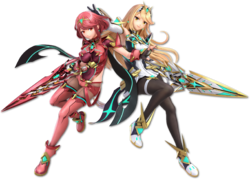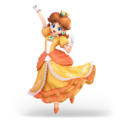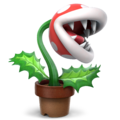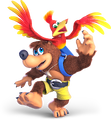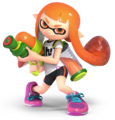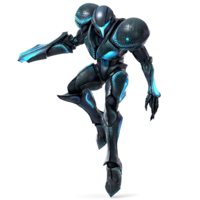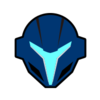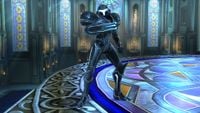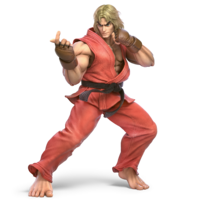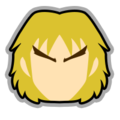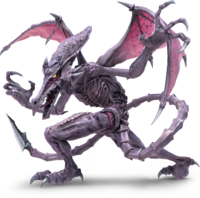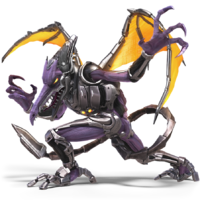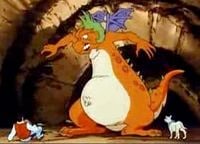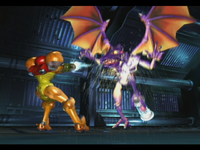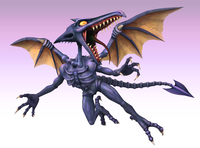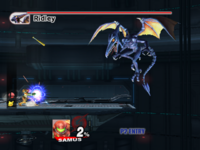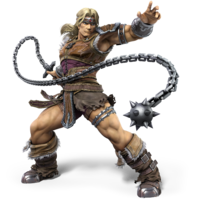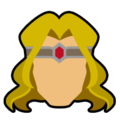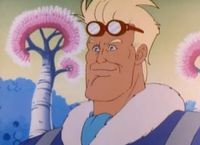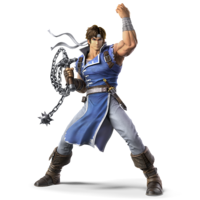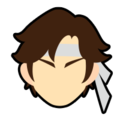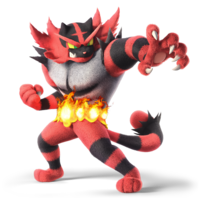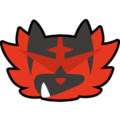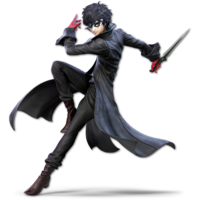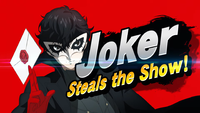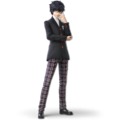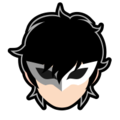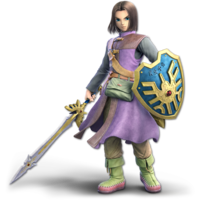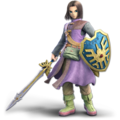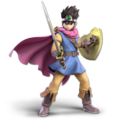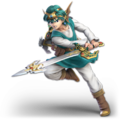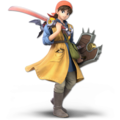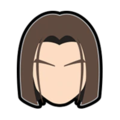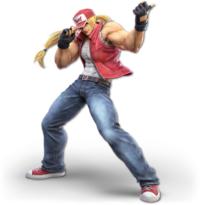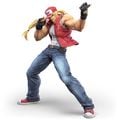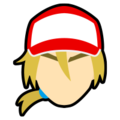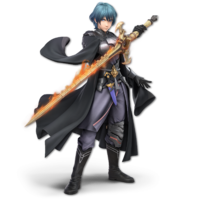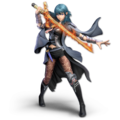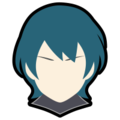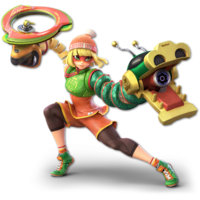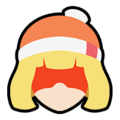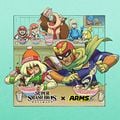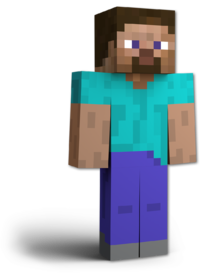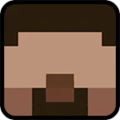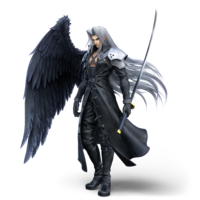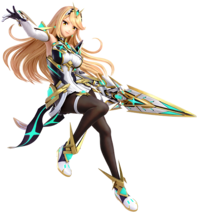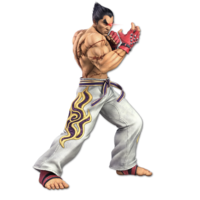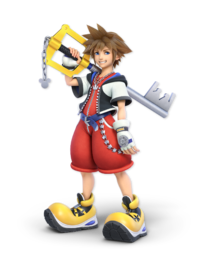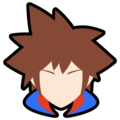List of fighters debuting in Super Smash Bros. Ultimate
This is a list of Super Smash Bros. series fighters that debuted in Super Smash Bros. Ultimate. The page details their role in this series as well as other Super Mario-related media. Super Mario characters, as well as characters not originally from the Super Mario franchise who have had at least one significant appearance in bona fide Super Mario media, are covered in detail on their own articles.
See also:
- List of fighters debuting in Super Smash Bros.
- List of fighters debuting in Super Smash Bros. Melee
- List of fighters debuting in Super Smash Bros. Brawl
- List of fighters debuting in Super Smash Bros. for Nintendo 3DS and Super Smash Bros. for Wii U
Fighters with articles[edit]
Dark Samus[edit]
- “Dark Samus is a living Phazon entity with the radioactive substance Phazon as her energy supply. She has a wide range of abilities, like being able to teleport, cloak herself, and attack with an arm cannon.”
- —Tips, Super Smash Bros. Ultimate
Dark Samus is the main antagonist of two Metroid Prime games of the Metroid series. Revealed in Metroid Prime 2: Echoes as a doppelgänger of Samus, Dark Samus is actually the result of Metroid Prime fusing itself with Samus' Phazon Suit (and a sample of Samus' DNA by extension) following its defeat on Tallon IV in Metroid Prime.
Super Smash Bros. Ultimate[edit]
- SmashWiki article: Dark Samus (SSBU)
Dark Samus is as an unlockable playable character in Super Smash Bros. Ultimate; this marks not only her playable debut in the Super Smash Bros. series, but also her first playable appearance in any game. Due to being an Echo Fighter of Samus, Dark Samus fights almost exactly like Samus, but has a number of different animations and unique taunts and victory poses. Compared to Samus, Dark Samus uses Phazon in her moveset, as indicated by blue flames with an electric effect for all but two of Samus' respective flame-based attacks, and dark blue energy for Charge Shot and Zero Laser. In addition, her rolls involve her evading via levitation instead of transforming into a Morph Ball.
In Ultimate's Adventure Mode, World of Light, Dark Samus is not seen when the fighters oppose Galeem for the first time. However, she, like every fighter except Kirby, is hit by one of Galeem's beams of light and imprisoned in the World of Light, where a Puppet Fighter of her is created. Said Puppet Fighter initially serves Galeem, but is later brought under Dharkon's control. The Dharkon-serving Dark Samus Puppet Fighter is eventually defeated, freeing the real Dark Samus and thus enabling her to join Kirby's team against Galeem and Dharkon.
Dark Samus is a heavy fighter, being heavier than Wario, Ike, Ridley, Simon, and Richter but lighter than Piranha Plant, while having the same weight as Samus, Bowser Jr. (and the Koopalings), and Terry.
Classic Mode route[edit]
Dark Samus' Classic Mode route is titled "The Great Poison Given Form", where she teams up with "dark" versions of characters (in reference to Phazon Corruption) against protagonists.
| The Great Poison Given Form | ||||
|---|---|---|---|---|
| Round | Opponent(s) | Rule | Stage | Song |
| 1 | Link | Team Battle (Ally: Zelda) |
Hyrule Castle | Hyrule Castle (Outside) |
| 2 | Chrom, Lucina | Team Battle (Ally: Robin) |
Arena Ferox | Power-Hungry Fool |
| 3 | Ryu | Team Battle (Ally: Ken) |
Suzaku Castle | M. Bison Stage Type B |
| 4 | Squirtle, Charizard, Pikachu | Team Battle (Ally: Ivysaur) |
Saffron City | Battle! (Team Galactic) |
| 5 | Mario, Peach, Daisy | Team Battle (Ally: Luigi) |
Princess Peach's Castle | Main Theme - Luigi's Mansion (Brawl) |
| 6 | Samus, Ridley | Free-for-All | Norfair | Vs. Ridley (Brawl) |
| Final | Master Hand, Crazy Hand (intensity 7.0 or higher) | Final Destination | Master Hand Master Hand / Crazy Hand (intensity 7.0 or higher) | |
Gallery[edit]
[edit]
Super Smash Bros. series[edit]
Super Smash Bros. Brawl[edit]
In Super Smash Bros. Brawl, Dark Samus appears as both a collectible trophy and a sticker, both of which depict her appearance in Metroid Prime 2: Echoes. In Brawl's Adventure Mode, The Subspace Emissary, her sticker can only be equipped by Samus and Zero Suit Samus, and gives them a +11 increase in their battering resistance when equipped.
A "Dark Samus" appears in co-op Event 7: Battle of the Dark Side. Although it is meant to represent Dark Samus herself, this Dark Samus is merely Samus' model recolored entirely black.
Super Smash Bros. for Nintendo 3DS / Super Smash Bros. for Wii U[edit]
Dark Samus appears as an Assist Trophy in Super Smash Bros. for Nintendo 3DS and Super Smash Bros. for Wii U, taking her appearance from Metroid Prime 3: Corruption. She attacks using a variety of Phazon-based abilities, such as tentacles that sprout from the ground, a scattershot of bullet-like blasts from her Arm Cannon, or a barrage of energy balls that home in on enemies. If enough damage is dealt to Dark Samus, a ball of light forms around her before she disappears; otherwise, she simply disappears after a period of time. Dark Samus is also the basis for one of Samus' alternate colorations.
Names in other languages[edit]
| Language | Name | Meaning | Notes |
|---|---|---|---|
| Japanese | ダークサムス[?] Dāku Samusu |
Dark Samus | |
| Chinese (simplified) | 黑暗萨姆斯[?] Hēi'àn Sàmǔsī |
Dark Samus | |
| Chinese (traditional) | 黑暗薩姆斯[?] Hēi'àn Sàmǔsī |
Dark Samus | |
| Dutch | Dark Samus[?] | - | |
| French | Samus sombre[?] | Dark Samus | |
| German | Dunkle Samus[?] | Dark Samus | |
| Italian | Samus Oscura[?] | Dark Samus | |
| Korean | 다크 사무스[?] Dakeu Samuseu |
Dark Samus | |
| Russian | Тёмная Самус[?] Tyomnaya Samus |
Dark Samus | |
| Spanish | Samus oscura[?] | Dark Samus |
Chrom[edit]
- “Anything can change!”
- —Chrom, Super Smash Bros. Ultimate
Chrom is the prince (and eventual ruler) of Ylisse, father of Lucina, and a distant descendant of Marth who makes his debut in Fire Emblem Awakening. During the events of the game, he meets and befriends Robin, who joins him and his military band, the Shepherds, in defeating the Fell Dragon Grima. He wields Falchion, the same sword wielded by Marth, albeit heavily reforged.
In English, Chrom is voiced by Matthew Mercer,[1] who has voiced him in the dubbed Fire Emblem games, while Tomokazu Sugita, Chrom's Japanese voice actor in the Fire Emblem series, provides his voice in the Japanese version.[2]
Super Smash Bros. Ultimate[edit]
- SmashWiki article: Chrom (SSBU)
In the Nintendo Direct broadcast on August 8, 2018, Chrom was announced as a playable character in Super Smash Bros. Ultimate, being an Echo Fighter of Roy. The main gameplay difference distinguishing Chrom from Roy is that his sword attacks deal consistent damage regardless of his distance from the opponent, similarly to Lucina's main difference from Marth. While Chrom shares many similar moves with him, he also possesses a move that is similar to Ike's Aether, Soaring Slash, though instead of throwing his sword, he slashes upward, sending opponents into the air. Several of Chrom's moves also lack Roy's fire effects, namely his up smash attack, down air attack and all of his special moves. For his Final Smash, Awakening Aether, Chrom performs a single slash, stunning any opponents in front of him, and performs his Aether skill from Fire Emblem Awakening, lunging forward and launching them away.
Despite being a playable character, Chrom still appears in Robin's Final Smash and one of Robin's victory poses. Initially, Chrom had the generic Fire Emblem victory theme from the previous games, albeit sped up (akin to Marth, Roy, and Ike), despite Lucina and Robin's victory theme having been replaced by a short arrangement of "Id (Purpose)", a song from Fire Emblem Awakening. Chrom's victory theme was changed to Lucina and Robin's version through the version 3.0.0 update released on April 17, 2019.
Chrom is one of the two newcomers that use the "Joins the battle!!!" tagline (as with the Japanese and British English versions) regardless of region, with the other being Dark Samus.
Chrom has average weight, being heavier than Ness, Lucas, Inkling, and Mii Brawler, but lighter than Pit, Dark Pit, Wii Fit Trainer, and Pokémon Trainer's Ivysaur, while having the same weight as Roy, Pac-Man, and Robin.
Classic Mode route[edit]
| Fight as One | ||||
|---|---|---|---|---|
| Round | Opponent(s) | Rule | Stage | Song |
| 1 | Lucina | Arena Ferox | Id (Purpose) | |
| 2 | Fox, Falco | Team Battle (Ally: Lucina) |
Lylat Cruise | Space Armada |
| 3 | Ness, Lucas | Team Battle (Ally: Robin (female)) |
Onett | Pollyanna (I Believe in You) |
| 4 | Donkey Kong, Diddy Kong | Team Battle (Ally: Lucina) |
Jungle Japes | Jungle Hijinxs |
| 5 | Peach, Daisy | Team Battle (Ally: Robin (male)) |
Mario Circuit | Rainbow Road - Mario Kart: Double Dash!! |
| 6 | Simon, Richter | Team Battle (Ally: Lucina) |
Dracula's Castle | Vampire Killer |
| Final | Master Hand, Crazy Hand | Team Battle (Ally: Robin (female)) |
Final Destination | Master Hand / Crazy Hand |
Gallery[edit]
[edit]
Super Smash Bros. for Nintendo 3DS / Wii U[edit]
Chrom appears as a non-playable character in Super Smash Bros. for Nintendo 3DS / Wii U as part of Robin's Final Smash, Pair Up. When the move is used, Chrom appears and dashes forward, sending any opponents in his way into the air. Chrom and Robin then both follow up with a series of attacks culminating with a downward blow that launches opponents. Chrom also appears as a collectible trophy and an online profile icon, and occasionally appears alongside Robin in their victory pose.
Originally, Super Smash Bros. series director Masahiro Sakurai considered adding Chrom as a playable character, but felt he didn't possess any unique characteristics and would be too similar to other sword-wielding fighters such as Marth and Ike.[3] This is referenced in Super Smash Bros. for Wii U in the Palutena's Guidance conversation for Robin, in which Chrom makes a guest appearance. Chrom also appears in Robin and Lucina's introduction trailer, where he is seen lying on the ground, having been defeated by Captain Falcon.
Gallery[edit]
WarioWare Gold[edit]
Outside of the Super Smash Bros. series, Chrom makes a cameo appearance in WarioWare Gold in 5-Volt's microgame Fire Emblem Awakening, where the objective is to direct Chrom to the enemy (Victor) and defeat him.
Names in other languages[edit]
| Language | Name | Meaning | Notes |
|---|---|---|---|
| Japanese | クロム[?] Kuromu |
Chrom | |
| Chinese | 庫洛武 (Traditional) Kùluòwǔ 库洛姆 (Simplified) Kùluòmǔ[?] |
Chrom | |
| Dutch | Chrom[?] | - | |
| French | Chrom[?] | - | |
| German | Chrom[?] | - | |
| Italian | Chrom[?] | - | |
| Korean | 크롬[?] Keurom |
Chrom | |
| Portuguese | Chrom[?] | - | |
| Russian | Хром[?] Khrom |
Chrom | |
| Кром[?] Krom |
Super Smash Bros. Ultimate | ||
| Spanish | Chrom[?] | - |
Ken[edit]
- “Bring it on!”
- —Ken Masters, Super Smash Bros. Ultimate
Ken Masters is one of the central characters of Capcom's Street Fighter series. He is the best friend and rival to Ryu and uses improved Shoryuken ki techniques to fight. He has made crossover appearances in the Super Smash Bros. series.
Super Smash Bros. Ultimate[edit]
- SmashWiki article: Ken (SSBU)
Ken appears in Super Smash Bros. Ultimate, as an unlockable character and an Echo Fighter to Ryu. He shares many similarities to Ryu, though he has multiple gameplay differences, including multiple entirely different moves (e.g. side smash attack, neutral air attack, up air attack, Final Smash etc.), and he moves slightly faster. His Shoryuken and Tatsumaki Senpukyaku can hit multiple times unlike Ryu's variants, and his Hadoken is shaped differently while also having a graphic of his hands displayed within. Additionally, he can perform two unique command-input moves that Ryu cannot perform, though Ken cannot perform the Shakunetsu Hadoken. He shares his debut trailer with Incineroar. In said trailer, Ken, on the Boxing Ring stage, successfully KOs Little Mac, before being knocked out himself by Incineroar. Some of Ken's standard moves have nicknames: standard attack is Inazuma Kick; tapped and held down tilts are Light Ankle Kick and Heavy Ankle Kick, respectively; and back throw is Hell Wheel.
As a somewhat heavy fighter, Ken's weight is equal to that of Ryu, while he is lighter than Link, Yoshi, Captain Falcon, Min Min, and Mii Gunner, but heavier than Mega Man.
Ken's fighter spirit uses his artwork from Street Fighter II: The New Challengers.
Classic Mode route[edit]
| Red-Hot Rivalry | ||||
|---|---|---|---|---|
| Round | Opponent(s) | Stage | Song | |
| 1 | Dark Pit | Palutena's Temple (Battlefield) | Dark Pit's Theme | |
| 2 | Wolf | Venom | Star Wolf's Theme / Sector Z (for 3DS / Wii U) | |
| 3 | Dark Samus | Frigate Orpheon | Multiplayer - Metroid Prime 2: Echoes | |
| 4 | Link (dark costume) | Temple | Great Temple / Temple | |
| 5 | Luigi | Mario Bros. | Underground Theme - Super Mario Bros. | |
| 6 | Ryu | Suzaku Castle (Ω) | Ryu Stage | |
| Final | Master Hand (intensity 7.0 or higher), Crazy Hand | Final Destination | Crazy Hand Master Hand / Crazy Hand (intensity 7.0 or higher) | |
Gallery[edit]
[edit]
Club Nintendo[edit]
The German Club Nintendo magazine published a 1992 comic titled Super Mario Klemp-Won-Do: Muskeln sind nicht alles!, which features various characters from the Street Fighter series. Among the characters Mario meets in the comic are E. Honda, Dhalsim, Chun-Li, Blanka, and Ken.
Super Smash Bros. for Nintendo 3DS / Wii U[edit]
In Super Smash Bros. for Nintendo 3DS and Super Smash Bros. for Wii U, Ken appears as a trophy.
Names in other languages[edit]
| Language | Name | Meaning | Notes |
|---|---|---|---|
| Japanese | ケン・マスターズ[?] Ken Masutāzu |
Ken Masters | |
| Chinese | 肯[?] Kěn |
Ken | |
| German | Ken[?] | - | |
| Russian | Кен[?] Ken |
Ken |
Ridley[edit]
- “Ridley Hits the Big Time!”
- —Introduction, "A Piercing Screech" Trailer for Super Smash Bros. Ultimate
Ridley is a high-ranking member of the Space Pirates, and one of the main villains in the Metroid series of video games. He is directly responsible for the murder of Samus's mother and partially responsible for the death of her father. In several instances, Ridley appears as an upgraded cybernetic version of himself called Meta Ridley. In addition to the Metroid series, Ridley has made an appearance in all games in the Super Smash Bros. series (aside from Super Smash Bros. for Nintendo 3DS), as well as in Nintendo Land in animatronic form.
Super Smash Bros. Ultimate[edit]
- SmashWiki article: Ridley (SSBU)
In Super Smash Bros. Ultimate, Ridley is a playable character for the first time, announced during the E3 2018 Nintendo Direct alongside fellow newcomers Inkling and Daisy. His appearance in this game seems to primarily be based off of that in Super Metroid, while he has a similar size to his appearance in the original Metroid. His Final Smash involves him slamming an opponent or opponents against Samus's Gunship and shooting plasma at the ship; the falling gunship can be seen in the background after the attack. Two of his alternate costumes swap him out for Meta Ridley (although he is still referred to in-game as simply "Ridley").
Ridley does not share a victory theme with Samus, instead using an intense and sinister variation of the Metroid victory theme; the flourish itself is shared with Dark Samus, and this trait is shared with fellow newcomers Chrom, King K. Rool, and Piranha Plant, as well as several veterans, namely Meta Knight, Bowser, Bowser Jr. (and the Koopalings), Rosalina & Luma, Dark Pit, Robin, Lucina, and Corrin.
In his reveal trailer, "A Piercing Screech" Mario, Mega Man, and Samus are traversing through a mechanical room on a walkway. Ridley stealthily takes Mega Man and Mario out by impaling the former with his tail and crushing the latter's head. Samus eventually senses something amiss and points her arm cannon behind her, only to find Mario's discarded hat. Suddenly, the walkway quakes with Ridley bursting out from underneath and knocking a shocked Samus off her feet. Ridley then proceeds to roar before giving an inhuman smirk as he twirls Mario's hat around his finger. In the ending of the trailer, Ridley, after presumably causing a blaze to kill Samus, is flapping his wings only to glare in slight irritation when Zero Suit Samus uses her Jet Boots to leap from the blaze and descend down to attack him.
Ridley is a heavy fighter, being heavier than Snake, R.O.B., and Banjo & Kazooie but lighter than Samus, Bowser Jr. (and the Koopalings), Dark Samus, and Terry, while having the same weight as Wario, Ike, Simon, and Richter.
Ridley's stock artwork in Super Smash Bros. Ultimate resembles Bowser's stock artwork from Super Smash Bros. for Nintendo 3DS / Wii U.
Ridley's splash screen introduction in his Super Smash Bros. Ultimate reveal trailer, "Ridley Hits the Big Time!", may be a reference to "Ridley is Too Big", an Internet meme originating from arguments against Ridley being a playable character in the Super Smash Bros. series.
His appearance in Ultimate is the first game to directly showcase his more intelligent and cunning personality traits, as while various sources in both prior Smash games as well as his home franchise (most directly in the Metroid manga) strongly implied that he possessed these traits, they were not immediately apparent in his characterization in the games, where he is generally portrayed as simply a monster.
Classic Mode route[edit]
| It Can't Be! Space Pirates! | ||||
|---|---|---|---|---|
| Round | Opponent(s) | Stage | Song | |
| 1 | Samus | Norfair | Title Theme - Metroid | |
| 2 | Fox, Falco | Venom | Break: Through the Ice | |
| 3 | Olimar | Distant Planet | Fragment of Hope | |
| 4 | Rosalina, Mario, Peach | Mario Galaxy | Fated Battle | |
| 5 | Meta Knight | Halberd | Dangerous Dinner | |
| 6 | Zero Suit Samus | Frigate Orpheon | Vs. Ridley | |
| Final | Master Hand, Crazy Hand (intensity 7.0 or higher) | Final Destination | Master Hand Master Hand / Crazy Hand (intensity 7.0 or higher) | |
Gallery[edit]
[edit]
Captain N: The Game Master[edit]
Ridley makes a cameo in the episode, "Gameboy" in Captain N: The Game Master, depicted as a large orange dragon. He also makes appearances in the Valiant adaptation of the series released for the Nintendo Comics System, where he looks more like his American artwork for Metroid, being a blue, multi-eyed, pteranodon-like alien.
Super Smash Bros. series[edit]
Super Smash Bros.[edit]
In Super Smash Bros., Ridley can occasionally be seen flying in the background of the Planet Zebes arena.
Super Smash Bros. Melee[edit]
Ridley also makes a brief appearance in the opening cinematic of Super Smash Bros. Melee, where he can be seen battling his archenemy, Samus. A trophy of Ridley can also be obtained in this game. Ridley's trophies in Melee and Brawl both state that he is the head of the Space Pirates on Zebes. This is false, however, with the real head being Mother Brain as well as Space Pirate Command.
Super Smash Bros. Brawl[edit]
In Super Smash Bros. Brawl, Ridley is fought twice in the Subspace Emissary.
The first time he is encountered, he is fought by Samus and Pikachu. As the two reach the exit to The Research Facility, where her Power Suit had been held, Ridley appears without warning and snatches up Samus. Roaring, he slams her into a wall and drags her along it. Pikachu comes to Samus's rescue, hitting the space dragon with a Thunder attack, after which the battle begins. Ridley fights similarly to Master Hand, using many brutal physical attacks. When he is defeated, he falls off the arena.
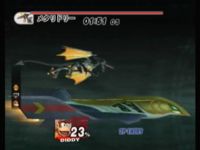
He later reappears as Meta Ridley, attacking a group including Captain Falcon, Captain Olimar, R.O.B., Samus, Pikachu, Diddy Kong, and Donkey Kong as they try to escape the floating Isle of the Ancients before it is engulfed in subspace.
As this battle is fought while trying to escape an island, there is a set time limit of two minutes that the player has to defeat Meta Ridley, who is more difficult to beat than Ridley was. Additionally, there is the added difficulty of the battle taking place on top of Captain Falcon's ship, the Falcon Flyer, so it is possible for the player to fall off the edge and lose.
Meta Ridley uses some of the same attacks as Ridley did, such as scraping his tail across the top of the Flyer and firing fireballs, but also shows additional ones that involve grabbing the Falcon Flyer and lowering it down with his weight, sometimes even lowering it off of the screen. Fortunately, most of Meta Ridley's attacks can be avoided by jumping off the Falcon Flyer at the right time. Meta Ridley's fireballs can also be reflected right back at him. Due to the time limit that is given during the Meta Ridley battle, Trophy Stands will appear more frequently, especially on the easier skill levels.
If the player manages to defeat Meta Ridley, a cutscene is shown, and the Falcon Flyer escapes while the island is engulfed into subspace.
Both fights are reprised in The Great Maze with any characters that have been rescued throughout the Subspace Emissary. He is also fought in the Boss Battles game mode. There is no time limit when fighting Meta Ridley in either The Great Maze or in Boss Battles mode.
Super Smash Bros. for Wii U[edit]
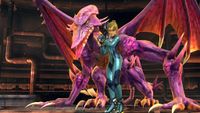
In Super Smash Bros. for Wii U, Ridley is a stage hazard boss on the Pyrosphere stage. His physical appearance, like Samus's, is based on his appearance from Metroid: Other M. Once attacked enough by a player, Ridley allies with that player, and attacks the other players. He can also transform into Meta Ridley by absorbing enough energy. He can be defeated, and, as if he was a character, defeating him rewards the player with a K.O. point; he can be defeated by his own ally as well.[4] Ridley's stock icon for Super Smash Bros. for Wii U uses his appearance from Super Smash Bros. Brawl instead of his Metroid: Other M appearance.
Nintendo Monopoly[edit]
Ridley appears in Nintendo Monopoly, in which he takes the place of Tennessee Avenue. He costs $180.
Nintendo Land[edit]

In Nintendo Land, an animatronic Ridley appears as a recurring antagonist in the Metroid Blast attraction. Ice Ridley, a version of Ridley unique to this game, also appears.
Names in other languages[edit]
- Ridley
| Language | Name | Meaning | Notes |
|---|---|---|---|
| Japanese | リドリー[?] Ridorī |
Ridley (named after Ridley Scott, director of Alien, with the name itself being of English origin and means "Reed clearing; cleared land; barren land", befitting his bloodthirsty personality.) | |
| Chinese | 利德雷[?] Lìdéléi |
Ridley | |
| Korean | 리들리[?] Lideulli |
Ridley | |
| Russian | Ридли[?] Ridli |
Ridley | |
| Spanish | Ridley[?] | - |
- Meta Ridley
| Language | Name | Meaning | Notes |
|---|---|---|---|
| Japanese | メタリドリー[?] Meta Ridorī |
Meta Ridley | |
| French | Méta Ridley[?] | Meta Ridley | |
| Korean | 메타 리들리[?] Meta Lideulli |
Meta Ridley | |
| Russian | Мета-Ридли[?] Meta-Ridley |
Meta-Ridley | |
| Spanish | Meta Ridley[?] | - |
Simon[edit]
- “I've vanquished the darkness!”
- —Simon Belmont, Super Smash Bros. Ultimate
Simon Belmont is a protagonist from Konami's Castlevania video game series, debuting in its very first entry. He crosses over with characters from the Super Mario franchise in episodes of Captain N: The Game Master and again in Super Smash Bros. Ultimate. His descendant, Richter Belmont, also appears in the latter as his Echo Fighter.
Super Smash Bros. Ultimate[edit]
- SmashWiki article: Simon (SSBU)
Simon makes his Super Smash Bros. debut in Super Smash Bros. Ultimate as a third-party playable character, alongside fellow Konami characters Solid Snake and Richter Belmont. He was announced to be playable in the game during the August 2018 Super Smash Bros. Ultimate Direct, alongside fellow newcomers Richter, Chrom, Dark Samus, and King K. Rool.
Simon's various attacks involve him using his "Vampire Killer" whip. His special attacks are Axe, an axe that is a powerful projectile; Holy Water, a magical, multi-hitting projectile dealing flame damage; Cross, a projectile with boomerang-esque properties; and Uppercut, a powerful uppercut that functions as Simon's recovery move. His Final Smash, Grand Cross, involves trapping players in a coffin and destroying it. Simon's whip is long-ranged, being effective to use from far distances. Simon's forward, back, and up aerials also function as tether recoveries, making them useful for recovering when close to an edge.
Keith Silverstein, Simon's English voice actor in Castlevania: Judgment, reprises his role as Simon. Hideo Ishikawa, who voiced Simon in DreamMix TV World Fighters, also reprises the role in the Japanese version.
In his debut trailer, he arrives at Dracula's Castle and eliminates Death shortly after the latter killed Luigi. He later confronts Dracula himself but is nearly defeated, only to be saved by his descendant Richter.[5]
Similar to King Dedede in Super Smash Bros. Brawl and Lucina in Super Smash Bros. for Nintendo 3DS / Wii U, Simon's name is announced differently in the Japanese version to reflect the pronunciation in that language. This trait is also shared with Richter and King K. Rool.
In the Adventure mode, Simon is seen standing near a cliff when he and the other fighters oppose Galeem for the first time. Although Simon is not shown to be hit by Galeem's beams directly, he, like every fighter except Kirby, is imprisoned in the World of Light, where a Galeem-serving puppet fighter of him is created. Simon is later freed after his puppet fighter is defeated, and he subsequently joins Kirby's team against Galeem and later Dharkon.
Simon is a heavy fighter, being heavier than Snake, R.O.B., and Banjo & Kazooie but lighter than Samus, Bowser Jr. (and the Koopalings), Dark Samus, and Terry, while having the same weight as Wario, Ike, Ridley, and Richter.
Classic Mode route[edit]
| Smash-vania | ||||
|---|---|---|---|---|
| Round | Opponent(s) | Rule | Stage | Song |
| 1 | King K. Rool, Incineroar (black costume) | Dracula's Castle (Battlefield) | Vampire Killer | |
| 2 | Giant Ridley | Luigi's Mansion (Ω) | Out of Time | |
| 3 | Bayonetta, Dark Pit | Free-for-All | Umbra Clock Tower | Bloody Tears / Monster Dance |
| 4 | Charizard (blue costume), King Dedede (green costume) | Kalos Pokémon League | Beginning | |
| 5 | Bowser, Ganondorf, Mewtwo | Reset Bomb Forest | Simon Belmont Theme (The Arcade) | |
| 6 | Richter | Dracula's Castle | Divine Bloodlines | |
| Final | Dracula | Nothing to Lose Black Night | ||
Gallery[edit]
[edit]
Captain N: The Game Master[edit]
Simon Belmont is a recurring character in the television series Captain N: The Game Master. In the series, he resides in Videoland (specifically the location Castlevania), and is a member of the N Team. In the pilot episode, "Kevin in Videoland", Simon helps the other heroes rescue Princess Lana, and they then battle Mother Brain and her allies throughout the show. A recurring gag in the series involved him frequently checking himself on a handheld mirror, and admiring himself. Andrew Kavadas portrayed him in the series.
Names in other languages[edit]
| Language | Name | Meaning | Notes |
|---|---|---|---|
| Japanese | シモン・ベルモンド[?] Shimon Berumondo |
Simon Belmont (alternatively Belmondo or Belmond); "Simon" is possibly a pun on the Japanese phrase 「死門」 (Shimon, Gates of Death), befitting the series' horror theme. | |
| Finnish | Simon Belmont[?] | - | |
| Korean | 사이먼[?] Saimeon |
Simon | |
| Russian | Саймон[?] Saymon |
Simon |
Richter[edit]
- “Begone! You don't belong in this world, monster!”
- —Richter Belmont, "Vampire Killer" trailer for Super Smash Bros. Ultimate
Richter Belmont is a character from Konami's Castlevania video game series, and the descendant of Simon Belmont, who debuted as the main protagonist of Castlevania: Rondo of Blood. Richter faces the resurrected Dracula in the year 1792, storming Castlevania after the town of Aljiba was burned by Dracula's forces and innocent maidens were kidnapped, including Richter's girlfriend Annette. He is a playable fighter in Super Smash Bros. Ultimate.
Super Smash Bros. Ultimate[edit]
- SmashWiki article: Richter (SSBU)
Richter makes his Super Smash Bros. debut in Super Smash Bros. Ultimate as a third-party character. He appears alongside fellow Konami characters Solid Snake and Simon Belmont, Sega's Sonic the Hedgehog, Bayonetta, and Joker, Capcom's Mega Man, Ryu, and Ken Masters, Bandai Namco's Pac-Man, Square Enix's Cloud Strife and Hero, Microsoft's Banjo & Kazooie, and SNK's Terry Bogard. He and Simon were confirmed to be in the game via a Nintendo Direct that took place on August 8th, 2018. Richter is voiced in English by David Vincent, reprising his role from previous Castlevania titles, including Portrait of Ruin, Harmony of Despair, and The Dracula X Chronicles[6]; and in Japanese by Kiyoyuki Yanada, his voice actor in Symphony of the Night.
Richter is classified as an Echo Fighter of Simon, with his moveset and animations being based directly on Simon's (although the two actually take inspiration from each other), making him the first third-party Echo Fighter and the only one of a newcomer instead of a veteran fighter. Richter's special attacks are Axe, an ax that is a powerful projectile; Holy Water, a multi-hitting projectile, with a blue flame that does aura damage instead of an orange burning one that does flame damage (as well as his only move with a gameplay-affecting difference from Simon's counterpart); Cross, a projectile with boomerang-esque properties; and Uppercut, a powerful uppercut that functions as his recovery move. Richter's Final Smash, Grand Cross, is functionally identical to Simon's identically-named Final Smash.
In Simon's debut trailer, he saves his ancestor Simon from Dracula's attack, and shouts a variant of his famous line from Castlevania: Symphony of the Night (quoted above), "Die monster. You don't belong in this world!"
Similar to King Dedede in Super Smash Bros. Brawl and Lucina in Super Smash Bros. for Nintendo 3DS / Wii U, Richter's name is announced differently in the Japanese version to reflect the pronunciation in that language. This trait is also shared with Simon and King K. Rool.
Classic Mode route[edit]
Richter's Classic Mode route has him fighting other Echo Fighters.
| Smash Echoes | ||||
|---|---|---|---|---|
| Round | Opponent(s) | Stage | Song | |
| 1 | Dark Samus | Norfair | Multiplayer - Metroid Prime 2: Echoes | |
| 2 | Daisy | Golden Plains | Mario Tennis / Mario Golf | |
| 3 | Lucina | Coliseum (Ω) | Destiny (Ablaze) | |
| 4 | Chrom | Arena Ferox | Id (Purpose) | |
| 5 | Dark Pit | Reset Bomb Forest | Dark Pit's Theme | |
| 6 | Ken | Suzaku Castle (Ω) | Ken Stage | |
| Final | Dracula | Dance of Illusions | ||
Gallery[edit]
Names in other languages[edit]
| Language | Name | Meaning | Notes |
|---|---|---|---|
| Japanese | リヒター・ベルモンド[?] Rihitā Berumondo |
Richter Belmont (alternatively Belmondo or Belmond); "Richter" is German pronunciation. | |
| Korean | 릭터[?] Ligteo |
Richter | |
| Russian | Рихтер[?] Rikhter |
Richter |
Incineroar[edit]
- “Incineroar Enters the Ring!”
- —Introduction, "Clash of Flames" trailer
Incineroar is a Fire/Dark-type Pokémon that debuted in Pokémon Sun and Pokémon Moon. It is the final evolution of Litten, evolving from Torracat beginning at level 34. In the English version of Super Smash Bros. Ultimate, Incineroar is voiced by H.D. Quinn, who has done voiceovers for the Pokémon Sun and Moon anime. In the Japanese version, Incineroar is voiced by Unshō Ishizuka, who died about four months before the release of Ultimate.
Super Smash Bros. Ultimate[edit]
- SmashWiki article: Incineroar (SSBU)
Incineroar appears as an unlockable playable character in Super Smash Bros. Ultimate. Its debut trailer was paired with Ken Masters's trailer, where the two briefly fight on the Boxing Ring stage. Prior to openly revealing itself, it also briefly wore a white hoodie when attacking Ken. Incineroar is unique in that it poses after performing a special move, though these poses can be canceled at any point and thus do not affect the fight.
In an interview with Nintendo Dream, Masahiro Sakurai revealed that during the development of Super Smash Bros. Ultimate, Decidueye was almost chosen as the new Pokémon fighter, but Incineroar was chosen instead, with Sakurai stating that he wanted to include a professional wrestler character.[7][8]
Incineroar is a super heavyweight fighter (being heavier than Kazuya but lighter than Ganondorf, while having the same weight as Pokémon Trainer's Charizard) with highly powerful attacks, yet very sluggish mobility to boot. In fact, Incineroar is notorious for having the slowest walking and dashing speeds in the game. Like Sonic the Hedgehog, Charizard, and Inkling, Incineroar receives minor damage while swimming, seemingly as a reference to its weakness to Water-type Pokémon in the Pokémon series. Fittingly, the overwhelming majority of Incineroar's attacks consist of professional wrestling moves, extending to its special moves.
Incineroar's neutral special move is Darkest Lariat, which involves it performing a series of discus lariats that can block projectiles. Its side special is Alolan Whip, in which it lunges at an opponent in order to Irish whip them into wrestling ring ropes and, depending on when the special button is pressed, subsequently perform a lariat, a back body drop, or collide with the opponent. Incineroar's up special is Cross Chop, which has it leap vertically into the air and descend diagonally to perform a cross chop that causes a small explosion upon hitting a surface. Lastly, its down special is Revenge, a type of counterattack that makes Incineroar receive minor damage in exchange for retaliating with a small burst of flame and making its next attack much stronger.
Classic Mode route[edit]
| Burning Pro Wrestling Spirit! | ||||
|---|---|---|---|---|
| Round | Opponent(s) | Rule | Stage | Song |
| 1 | Bowser | Boxing Ring | The Grand Finale | |
| 2 | Ganondorf | Molgera | ||
| 3 | Morton, Ludwig | Team Battle (Ally: Greninja) |
Boxing Ring (Battlefield) | Fortress Boss - Super Mario World |
| 4 | King K. Rool | Gang-Plank Galleon | ||
| 5 | Donkey Kong | Boxing Ring (Ω) | Boss 2 - DK: Jungle Climber | |
| 6 | Incineroar | Battle! (Lorekeeper Zinnia) | ||
| Final | Master Hand, Crazy Hand | Team Battle (Ally: Greninja) |
Final Destination | Master Hand / Crazy Hand |
Gallery[edit]
Names in other languages[edit]
| Language | Name | Meaning | Notes |
|---|---|---|---|
| Japanese | ガオガエン[?] Gaogaen |
From「ガオー」(gaō, onomatopoeia for roaring) and the conjugation of「火炎」(kaen, flame) | |
| Chinese (simplified) | 炽焰咆哮虎[?] Chìyàn Páoxiāo Hǔ |
Literally "Blazing-Flame Roaring Tiger" | |
| Chinese (traditional) | 熾焰咆哮虎[?] Chiyìhm Pàauhhāau Fú |
Literally "Blazing-Flame Roaring Tiger" | |
| Dutch | Incineroar[?] | - | |
| French | Félinferno[?] | From "félin" (feline) and "inferno" | |
| German | Fuegro[?] | From "fuego" (fire) and "growl" | |
| Italian | Incineroar[?] | - | |
| Korean | 어흥염[?] Eoheungyeom |
From 어흥 (eoheung, growl) and 염 (yeom, flame) | |
| Russian | Инсинероар[?] Insineroar |
Incineroar | |
| Spanish | Incineroar[?] | - |
Joker[edit]
- “This is Joker. The mission is go.”
- —Joker, "Take Your Heart" trailer for Super Smash Bros. Ultimate
Joker (whose real name is given as Ren Amamiya in the games and anime, although the player can edit it freely in the former, and as Akira Kurusu in the manga) is the protagonist of Persona 5, a PlayStation 3 and PlayStation 4 title from the Megami Tensei franchise's spin-off Persona series. In his game of origin, he is a Japanese high school student in his day life; however, he also has the power to access an alternate version of the world called the Metaverse. In said universe, Joker leads the Phantom Thieves, a group of teenagers who alter the psyche of corrupted souls to steal their hearts. Joker and his companions have the ability to summon Personas, which are manifestations of their respective psyches that possess special powers and are based on mythological figures. Joker's only appearance to date alongside Super Mario franchise characters has been in Super Smash Bros. Ultimate, where he was made available in Challenger Pack 1 as the first Fighters Pass DLC fighter.
Super Smash Bros. Ultimate[edit]
- SmashWiki article: Joker (SSBU)
During The Game Awards 2018, it was revealed that Joker would be appearing as a paid downloadable playable character in Super Smash Bros. Ultimate.[9] He is the second DLC fighter (with Piranha Plant being the first), and the first one in the first Fighters Pass, releasing as part of "Challenger Pack 1". Challenger Pack 1, including Joker, the Mementos stage, and music from the Persona series, was released on April 17, 2019 (PST).[10] Joker is classified as fighter #71.
Aside from being able to wall jump, Joker has a special mechanic known as the "Rebellion Gauge", which is a meter that slowly fills up either over time, when taking damage or when Joker is behind his opponents in score/stocks, and fills up faster when he is attacked when using his down special, Rebel's Guard (as well as halving the damage taken). When this meter fills completely, Joker will summon the Persona Arsene, who assists him in battle by attacking in tandem with him, increasing the power and range of his standard moves. Joker's special moves are also enhanced, and his down special changes to Tetrakarn and Makarakarn. When Arsene is present in battle, Joker's render in-game and in the HUD will have his mask (or glasses in his alternate costume) removed. If Joker gets KO'd, the gauge will reset.
The player can choose to play as six color variations of Joker's Phantom Thief outfit wearing his mask, as well as two versions of his Shujin Academy uniform wearing his glasses. The purple, blue, yellow, and red costumes are references to the thematic colors of Revelations: Persona, Persona 3, Persona 4, and Persona 5 respectively, the white thief costume matches the color palette of Goro Akechi while in his Crow attire, and the white Shujin Academy uniform reflects the color of Joker's summer uniform. His victory screen mimics the one from Persona 5, with the color of the screen changing to match the current colors of the stage Mementos if Joker were to win on that stage. If Joker wins the match with his Final Smash, the splash screen that appears at the end of the move will carry over to the victory screen. He is one of the lighter middleweight fighters, being heavier than the Ice Climbers, Lucario, Wolf, Villager, Steve, and Mythra, but lighter than Ness, Lucas, Mii Brawler, and Inkling.
Joker shares his English voice actor, Xander Mobus, with the game's announcer, Master Hand, and Crazy Hand, as well as sharing his Japanese voice actor, Jun Fukuyama, with Roy. He is the only playable character in the series to be voiced by the announcer.
After Sonic the Hedgehog and Bayonetta, Joker is the third guest fighter to represent Sega, as Atlus, the developer of the Persona series, was acquired by Sega Sammy Holdings in 2013.
Joker appears as two DLC fighter spirits, depicting him in his Phantom Thief outfit and his Shujin Academy uniform, respectively. The former spirit is obtained by completing Classic Mode as Joker, while the latter can be purchased from the shop if Challenger Pack 1 has been downloaded. Being the leader of the group, Joker also appears in the artwork for the Phantom Thieves of Hearts spirit (which is also DLC), as well as in the associated spirit battle.
Classic Mode route[edit]
The route's title references Shadows, recurring enemies in the Persona series. The second, third, fourth, fifth, and sixth rounds each feature an opponent from the previous round as an ally; this could be a reference to Shadows being able to join the player's party as Personas in Persona 5. Joker is the one of three characters who face Master Hand and Crazy Hand as their final boss on the Ω form of a stage different from Final Destination, the other two being Donkey Kong on New Donk City Hall and Sephiroth on Northern Cave.
| Shadows | ||||
|---|---|---|---|---|
| Round | Opponent(s) | Rule | Stage | Song |
| 1 | Mr. Game & Watch ×6 | Horde Battle | Mementos | Last Surprise |
| 2 | Giant Kirby (Meta Knight unmasked costume) | Team Battle (Ally: Mr. Game & Watch (white costume)) |
Kalos Pokémon League | Aria of the Soul |
| 3 | Samus (black/yellow costume), Dark Samus (black/yellow costume) | Team Battle (Ally: Kirby (cyan costume)) |
Mementos | Mass Destruction |
| 4 | Meta Knight (black/red costume) | Team Battle (Ally: Dark Samus (gray/red costume)) |
Mementos (Battlefield) | Beneath the Mask |
| 5 | Link, Young Link, Toon Link (Dark Link costumes) | Team Battle (Ally: Meta Knight (yellow costume)) |
Mementos | Reach Out To The Truth |
| 6 | Incineroar (black costume) | Team Battle (Ally: Link (Fierce Deity Link costume)) |
Mementos (Ω) | Rivers In the Desert |
| Final | Master Hand, Crazy Hand (intensity 7.0 or higher) | Our Beginning | ||
Gallery[edit]
Names in other languages[edit]
| Language | Name | Meaning | Notes |
|---|---|---|---|
| Japanese | ジョーカー[?] Jōkā |
Joker | |
| Chinese | JOKER[?] | - | |
| Korean | 조커[?] Jokeo |
Joker | |
| Russian | Джокер[?] Dzhoker |
- | |
| Spanish | Joker[?] | - |
Hero[edit]
- “The Hero Draws Near!”
- —Introduction tagline, "Heroic Encounter" trailer for Super Smash Bros. Ultimate
The Hero is a title assigned to various main playable characters in the Dragon Quest series. Their background, appearance, skills, and roles of the heroes vary between the games, as they are all unique characters from one another.
Four of these heroes appear in Super Smash Bros. Ultimate as a singular downloadable character.[11] Each one of the four appears as a selectable costume for the character, with the default choice being the protagonist from Dragon Quest XI: Echoes of an Elusive Age.
Naming[edit]
In the Hero's gameplay showcase for Super Smash Bros. Ultimate, Masahiro Sakurai assigned each one a different nickname to differentiate between them. Their names are as follows:
They all represent a hero from a different Dragon Quest series game. Their origins are as follows:
- Eleven is from Dragon Quest XI: Echoes of an Elusive Age. Though he is officially known as the Luminary in his origin game, his nickname "Eleven" stems from the fact his game is the eleventh in the series.
- Arusu is from Dragon Quest III: The Seeds of Salvation. Within the Dragon Quest franchise and fanbase, he is commonly referred to as Erdrick.
- Solo is from Dragon Quest IV: Chapters of the Chosen, which is his default name in the game.
- Eight is from Dragon Quest VIII: Journey of the Cursed King. His name stems from the fact his game is the eighth in the series.
Despite this, their nicknames are not used in-game at all; all menu screens and the announcer refer to all four incarnations of the character as "Hero". Their spirit also refers to them as Hero, with their origin game in parenthesis.
Super Smash Bros. Ultimate[edit]
- SmashWiki article: Hero (SSBU)
During the E3 2019 Nintendo Direct on June 11, 2019 (PST), both the heroes of Dragon Quest and Banjo & Kazooie were announced as DLC fighters for Super Smash Bros. Ultimate, with the former set to release during the summer of 2019 (PST) as the second fighter in the first Fighters Pass (as well as the third downloadable fighter overall), included within Challenger Pack 2. In a similar vein to Pokémon Trainer, Villager, Wii Fit Trainer, Robin, Olimar and Alph, Bowser Jr. and the Koopalings, Corrin, and Inkling, Eleven is the default skin for the character, while Asuru, Solo, and Eight can be chosen as alternative costumes. They all use a sword and shield, similar to Link, Young Link and Toon Link, and have access to magical abilities from their series, such as Sizzle. Many of their basic attacks use sword jabs and swings, with their shield able to block projectile attacks. Their magical attacks are limited by their MP gauge (which fills up over time or attack to fills its). Slime also appear alongside them during taunts. With the notable exception of Command Selection, Hero's special moves switch between three types of magical attacks depending on the charge level and costs higher amount of MP when charged for longer, much like Robin's Thunder. Hero's down special move, Command Selection, instead has him choosing a variety of four randomly selected spells from a pop-up menu similar to the one from the original game. Regarding weight, Hero is one of the lighter heavyweights, being lighter than Mega Man but heavier than Mii Swordfighter and Cloud. Challenger Pack 2, including Hero, the Yggdrasil's Altar stage, and music from the Dragon Quest series, was released on July 30, 2019 (PST)[11]. The Hero is classified as fighter #72.
In Hero's reveal trailer, Link is shown dueling puppet fighters of Marth and Meta Knight, both of whom were created by Dharkon. Link is overpowered by both puppet fighters, who prepare to rush him for a final hit. However, throughout their battle, a horse is galloping towards Link and the puppet fighters. When the Marth and Meta Knight puppet fighters are about to attack Link one more time, the Hero - revealed to be Eleven - attacks from behind, knocking away the puppet fighters from Link. Several gameplay clips of Eleven are shown: Eleven is KOing opponents at first, but is later KO'd himself several times. The gameplay cuts back to CGI, showing Dharkon's puppet fighter army cornering a weakened Eleven. Asuru, Solo, and Eight join to assist Eleven, where all four Heroes rush towards the puppet fighter army. Gameplay footage of all four Heroes is shown, where they all work together to KO their opponents. The Hero's trailer ends with Asuru using his Final Smash.
Each of the heroes has a palette swap that references another character or class from the series: Eleven's is based on Angelo, Arusu's is based on the hero of Dragon Quest V: Hand of the Heavenly Bride, Solo's is based on the hero of Dragon Quest, and Eight's is based on Terry from Dragon Quest VI: Realms of Revelation.
The hero, Arusu, also has his own Mii Fighter outfit and headgear (called Erdrick's Armor and Erdrick's Helmet, respectively) that Mii Fighters can don. The outfit is exclusive to Mii Swordfighters, while the helmet can be worn by any Mii Fighter class.
Each of the four Heroes has his own voice actor. Arusu's voice actor, Nobuyuki Hiyama, had previously voiced Link in The Legend of Zelda: Ocarina of Time, Super Smash Bros., and Super Smash Bros. Melee.
The Hero is the second fighter from Square Enix; following Cloud and preceding Sephiroth and Sora. The Hero is the first third-party character to have other characters from the same series as alternate costumes in the Super Smash Bros. series before Steve.
Luminary/Eleven's fighter spirit uses his artwork from Dragon Quest XI: Echoes of Elusive Age, Arusu/Erdrick's fighter spirit uses his artwork from Dragon Quest III: The Seeds of Salvation, Solo's fighter spirit uses his artwork from Dragon Quest IV: Chapters of the Chosen, and Eight's fighter spirit uses his artwork from Dragon Quest VIII: Journey of the Cursed King.
Classic Mode route[edit]
Aside from the final round, all matches in Hero's Classic Mode route are Stamina battles.
| A History of Heroism | ||||
|---|---|---|---|---|
| Round | Opponent(s) | Stage | Song | |
| 1 | Tiny Kirby (blue costume) ×3, Tiny Kirby (red costume) | Gaur Plain (Battlefield) | The Hero Goes Forth with a Determination | |
| 2 | Hero (XI), Tiny Robin (female, red costume) | Yggdrasil's Altar | Unflinchable Courage | |
| 3 | Hero (VI) | Temple | Wagon Wheel's March | |
| 4 | Rathalos | Fighting Spirits - DRAGON QUEST III | ||
| 5 | Hero (VIII), Tiny Pikachu | Gaur Plain (Battlefield) | War Cry | |
| 6 | Hero (III) | Castle Siege (volcanic area) | Adventure - DRAGON QUEST III | |
| Final | Robin (male, blue costume) Giant Charizard (purple costume) |
Dracula's Castle (Ω) | Fighting Spirits - DRAGON QUEST III Battle for the Glory - DRAGON QUEST IV | |
Gallery[edit]
Names in other languages[edit]
| Language | Name | Meaning | Notes |
|---|---|---|---|
| Japanese | 勇者[?] Yūsha |
Hero; literally "Brave One" | |
| Chinese | 勇者[?] Yǒngzhě |
Same as the Japanese name | |
| Dutch | Held[?] | Hero | |
| French | Héros[?] | Hero | |
| German | Held[?] | Hero | |
| Italian | Eroe[?] | Hero | |
| Korean | 용사[?] Yongsa |
Warrior | |
| Russian | Герой[?] Geroy |
Hero | |
| Spanish | Héroe[?] | Hero |
Terry[edit]
- “Hey, come on!”
- —Terry, "–Breaking News– The Challenger" trailer for Super Smash Bros. Ultimate
Terry Bogard is one of the main characters of SNK's Fatal Fury series, as well as the company's crossover series, The King of Fighters, first appearing in Fatal Fury: King of Fighters. He is one of SNK's most iconic characters, leading to his numerous appearances and roles in other fighting games.
Super Smash Bros. Ultimate[edit]
- SmashWiki article: Terry (SSBU)
During the September 2019 Nintendo Direct, Terry was announced to appear as a DLC fighter in Super Smash Bros. Ultimate, being included in Challenger Pack 4 of the first Fighters Pass and thus being the fifth downloadable fighter overall for the game.[12] His in-game design resembles his appearance in the older The King of Fighters games throughout the 1990s, while his animations during matches appear to be based off of his animations in The King of Fighters XII and The King of Fighters XIII. He was released along with the 6.0 update on November 6th, 2019 (PST).
In a similar vein to Ryu and Ken, Terry always faces his opponent in 1-on-1 battles, allowing him to walk backwards; however, he can still dash in any direction. Unlike Ryu and Ken, Terry sports inputs only for his special moves, though he has more inputs for said moves than the Street Fighter characters. Terry sports a unique comeback mechanic: once his damage percentage reaches 100% in Timed and Stock Battles, or he has 30% or less of his health in a Stamina Battle (indicated by a "Go" icon next to his portrait), he gains access to two "Super Special Moves" called Power Geyser and Buster Wolf. Terry has a somewhat slow walking speed, but he sports an average dashing speed and a high overall damage output. He is a heavyweight fighter, and specifically heavier than Ike, Wario, Ridley, Simon, and Richter, lighter than Piranha Plant, and weighing as much as Samus, Dark Samus, and Bowser Jr. (and the Koopalings).
Unlike most of the other fighters and much like Mega Man and Wii Fit Trainer, the majority of Terry's standard attacks (barring his grab, pummel, edge attack, and floor attacks) are named in reference to his moveset from his home series. Standard attack is Jab, Body Blow, High Kick; tilt attacks are Middle Kick, Rising Upper, and Under Kick respectively; dash attack is Power Charge; smash attacks are Backspin Kick, Wild Upper, and Slide Kick respectively; aerial attacks are Chop, Jump Kick, Jump Backward Kick, Somersault Kick, and Jump Karate Punch respectively; forward and back throws are both Buster Throw; and up and down throws are Grasping Upper and Neck Breaker Drop respectively.
During Terry's reveal trailer, several references to various SNK properties are shown in a series of "fake-out" attempts to receive the invitation. In order:
- The spinning letter with an "S" (for Sakurai or Smash) emblazoned on its seal is a reference to Rugal Bernstein's R-sealed letters from The King of Fighters, particularly The King of Fighters '94. The hand of the main protagonist of The King of Fighters, Kyo Kusanagi, is briefly shown attempting to grab it like in that game, but unlike the actual game, he fails to do so.
- Ryo Sakazaki of Art of Fighting is shown immediately after, using graphics from his own series' cutscenes as he unsuccessfully swipes at the letter.
- Andy Bogard and Joe Higashi, the other two playable characters in Fatal Fury: King of Fighters are then shown fighting over the letter.
- Geese Howard, Terry's nemesis, then attempts to grab the letter only to fall from his penthouse, parodying his death in the ending of Fatal Fury.
- Nakoruru of Samurai Shodown is then shown attempting to grab it via her hawk, Mamahaha.
- Iori Yagami of The King of Fighters games starting from The King of Fighters '95 then makes a slight attempt to grab it and, upon failing to do so, proceeds to perform his signature maniacal laugh.
- In the end, when Terry picks up the letter, his hand uses the sprite from his ending in Real Bout Fatal Fury where he unsuccessfully attempts to rescue Geese from falling to his death. The sprite of Terry lifting the letter up in the air is edited from the intro cinematic of the same game.
Terry's Challenger Pack came with the most music tracks out of any DLC franchise in the overall Super Smash Bros. series, with 50 new songs being added to Super Smash Bros. Ultimate. Before Terry's release, Simon and Richter debuted with the most songs (34 songs) out of any newcomer introduced to Super Smash Bros. Ultimate.
Terry Bogard's fighter spirit uses his artwork from Fatal Fury Special. Terry Bogard is one of the three DLC fighters who never appears as a puppet in any spirit battle, with the other two being Piranha Plant and Sephiroth.
Classic Mode route[edit]
All matches in Terry's Classic Mode route are Stamina battles, a trait shared only with Ryu's Classic Mode route. They are all made up of three characters with one trait in common, referencing how the teams in the King of Fighters series are set up.
| The King of Smash | ||||
|---|---|---|---|---|
| Round | Opponent(s) | Stage | Song | |
| 1 | Mario, Peach, Rosalina | King of Fighters Stadium | Ne! - KOF '94 | |
| 2 | Sheik, Link, Zelda | Prism Tower | Let's Go to Seoul! - FATAL FURY 2 | |
| 3 | Bowser, King Dedede, King K. Rool | Suzaku Castle (Ω) | Tarkun and Kitapy - FATAL FURY 2 | |
| 4 | Pit, Dark Pit, Palutena | Palutena's Temple (Battlefield) | Forest World - Athena | |
| 5 | Sonic, Mega Man, Pac-Man | Boxing Ring | ESAKA!! - KOF 2002 UM | |
| 6 | Ridley, Ganondorf, Bayonetta | Fourside (Ω) | Soy Sauce for Geese - KOF XIV | |
| Final | Ryu, Ken, Terry (*) | King of Fighters Stadium | Art of Fighting Ver.230000000.0 - FATAL FURY SPECIAL | |
(*) - Terry uses his blue costume if the player uses his default costume.
Gallery[edit]
Names in other languages[edit]
| Language | Name | Meaning | Notes |
|---|---|---|---|
| Japanese | テリー・ボガード[13] Terī Bogādo |
Terry Bogard | |
| Chinese (simplified) | 特瑞・博加德[?] Tèruì Bójiādé |
Terry Bogard | |
| Chinese (traditional) | 泰利‧波格[?] Tàilì Bōgé |
Terry Bogard | |
| Korean | 테리 보가드[?] Teri Bogadeu |
Terry Bogard | |
| Russian | Терри Богард[?] Terri Bogard |
Terry Bogard |
Byleth[edit]
- “Byleth Joins Smash House!”
- —Splash screen text (male), "The Ashen Demon" trailer for Super Smash Bros. Ultimate
- “Byleth Recruits... Byleth!”
- —Splash screen text (female), "The Ashen Demon" trailer for Super Smash Bros. Ultimate
Byleth Eisner is the main character of Fire Emblem: Three Houses, acting as the avatar character similar to Robin and Corrin before them. In Fire Emblem: Three Houses, they are a professor at the Officers Academy at the Garreg Mach Monastery, teaching one of the game's three titular houses (either the Black Eagles, led by Edelgard von Hresvelg, the Blue Lions, led by Dimitri Alexandre Blaiddyd, or the Golden Deer, led by Claude von Riegan), with the player's choice influencing the direction of the story. Byleth is capable of wielding a variety of weapons, including their main weapon, the Sword of the Creator.
Super Smash Bros. Ultimate[edit]
- SmashWiki article: Byleth (SSBU)
Byleth was confirmed as a playable fighter in Super Smash Bros. Ultimate as the fifth and final downloadable fighter of the first Fighters Pass during a presentation on January 16, 2020, being released on January 28, 2020.[14] Like with Robin and Corrin before them, Byleth has a male and female variant. Two of each of their color palettes refer to Dimitri and Claude for the male variant and Edelgard and Sothis for the female variant, and one other for both reference their mid-game hair color change.
All of Byleth's special moves revolve around the other legendary weapons of Three Houses. Their up special results in their sword extending into a whip, able to grab ledges and other characters similar to Joker's up special, though Byleth is able to jump off of the character, and is capable of spiking them downward if the opponent is at high enough damage. Byleth's standard special is the bow Failnaught, which acts much like Link's Bow, getting stronger the longer is it charged. Byleth's side special uses the lance Areadbhar, which is extended with a hard thrust that deals more damage at the tip, and can also be angled. Byleth's down special uses the axe Aymr, which is a strong, but slow, overhead swing attack that deals great damage to opponents, and provides Byleth with super armor. Their Final Smash is called Progenitor God Ruptured Heaven, which is an "upgraded" variant of the Ruptured Heaven skill in Three Houses, where Byleth calls upon Sothis to attack opponents. Byleth utilizes each of their weapons depending on their attacks: the Sword of the Creator for standard attack, tilt attacks, up smash, and up aerial; Failnaught for standard aerial; Areadbhar for forward smash, and forward and back aerials; and Aymr for down smash and down aerial.
Byleth has average weight, being heavier than Pit, Wii Fit Trainer, Dark Pit, and Pokémon Trainer's Ivysaur, but lighter than Mario, Dr. Mario, Corrin, and Pyra, while having the same weight as Luigi and Shulk.
By purchasing Byleth, players will also get the stage Garreg Mach Monastery, which is a transitioning stage that moves between four locations. Additional music from Three Houses is also included.
Byleth is the only member of the first Fighters Pass owned by Nintendo, as well as the only one from an already represented series, and the second DLC character in the game overall to be so, following Piranha Plant and preceding Min Min and Pyra / Mythra. Byleth is also the only fighter to have made their overall debut after the release of Super Smash Bros. Ultimate, having first appeared in 2019. Byleth is currently the only fighter in the franchise to have two taglines, largely because of both their being composed of two characters, and their technically having different names in Japan (the male Byleth being known as "Bereto" and the female Byleth being known as "Beresu").
Both male and female Byleth's fighter spirits use their artwork from Fire Emblem: Three Houses.
Classic Mode route[edit]
Similarly to Lucina and Young Link, Byleth's Classic Mode involves other Fire Emblem characters in the order their games of origin were released. Like with Ryu and Terry, all matches in Byleth's Classic Mode route are Stamina battles.
| A Heroic Legacy | ||||
|---|---|---|---|---|
| Round | Opponent(s) | Rule | Stage | Song |
| 1 | Marth | Temple | Story 5 Meeting | |
| 2 | Roy | Arena Ferox (Battlefield) | Winning Road - Roy's Hope | |
| 3 | Ike (Path of Radiance), Ike (Radiant Dawn) | Castle Siege | Eternal Bond | |
| 4 | Robin, Chrom, Lucina | Arena Ferox (Ω) | Id (Purpose) | |
| 5 | Corrin, Corrin (black costume) | Coliseum | Lost in Thoughts All Alone (for 3DS / Wii U) | |
| 6 | Byleth (Edelgard costume), Byleth (Dimitri costume), Byleth (Claude costume) | Garreg Mach Monastery | Fódlan Winds | |
| Final | Master Hand, Crazy Hand | Team Battle (Ally: Marth, Roy, Ike, Robin, Corrin) |
Final Destination | Code Name: F.E. |
Gallery[edit]
WarioWare: Move It![edit]
Male Byleth appears in WarioWare: Move It! as part of the Fire Emblem Engage microgame. He is one of four Emblem characters that can appear when the player wins the game.
Names in other languages[edit]
| Language | Name | Meaning | Notes |
|---|---|---|---|
| Japanese | ベレト (male)[15] Bereto ベレス (female)[15] Beresu |
Possibly "Beleth", but officially "Byleth". See: Byleth's etymology. | |
| Chinese (simplified) | 贝雷特[16] (male) Bèiléitè 贝雷丝[16] (female) Bèiléisī |
Transliteration from the Japanese name | |
| Chinese (traditional) | 貝雷特 (male)[17] Bèiléitè 貝雷絲 (female)[17] Bèiléisī |
Transliteration from the Japanese name | |
| Korean | 벨레트 (male)[18] Belleteu 벨레스 (female)[18] Belleseu |
Transliteration from the Japanese name | |
| Russian | Байлет[?] Bailet |
Byleth | |
| Spanish | Byleth[?] | - |
Min Min[edit]
- “Wǒ ài lāmiàn! (I love ramen!)”
- —Min Min, Super Smash Bros. Ultimate
Min Min is a fighter character originating from ARMS for the Nintendo Switch. She is a martial artist who is one of few people in the world with ARMS, a phenomenon that causes the person's arms (or on some occasions, other body parts) to mutate into long, stretchy material. She battles in the ARMS League to promote her family's ramen restaurant, Mintendo Noodle House.
Super Smash Bros. Ultimate[edit]
- SmashWiki article: Min Min (SSBU)
On March 26, 2020, it was announced that the first DLC fighter from the Fighters Pass Vol. 2 for Super Smash Bros. Ultimate would be from ARMS, although the identity of said representative would not be revealed until their release in June.[19] On June 22, 2020, the representative was revealed to be Min Min, and it was announced that she would be released alongside Spring Stadium via an update available June 29, 2020.[20] Prior to her inclusion, Min Min also appeared as a spirit in the game. Her spirit battle is against female Corrin (in her orange costume) on the Ω form of the New Pork City stage with Dragon Driftway's music from Mario Kart 8 playing in the background. Female Corrin will start the battle with a Unira, favors neutral specials, has increased attack power when badly damaged, and has increased move speed. Min Min is the first character to already have a spirit before appearing as a fighter; she would later be followed in this by Pyra / Mythra.
Min Min is a ranged fighter who utilizes her ARMS in combat. Her ARMS possess significant reach and lack hurtboxes, allowing Min Min to attack safely at a distance. However, Min Min's ARMS are burdened with sluggish attack speed and require precise aiming because of their hitboxes being located only on her ARMS' "fists". Like in ARMS, Min Min also utilizes kicks as part of her moveset.
Min Min has three types of ARMS that she can use in battle, all of which can be swapped out (albeit for her right ARM only): Ramram, a chakram that is weak, yet very maneuverable; Megawatt, a large, studded metallic sphere that exchanges range and speed for considerable power; and Dragon, which is fittingly shaped like a dragon's head and is effectively the middle ground between Ramram and Megawatt in regard to range, speed and power. Each of these ARMS also possess distinct secondary properties: sufficiently charging Ramram and Megawatt will result in them being set aflame and discharging electricity, respectively, whereas Dragon is capable of firing a short-ranged laser beam when the attack button is held, with the laser being further strengthened after being sufficiently charged. The Dragon ARM is Min Min's left ARM at all times and is uniquely capable of being powered up for approximately 20 seconds upon successfully throwing an opponent or while having access to her Final Smash.
Uniquely, Min Min does not have a standard or side special move.[21] Instead, the attack button and special move button (when pressed alone or while tilting left or right) are assigned to her left and right ARMS respectively. If both buttons are pressed, Min Min can simultaneously attack with both ARMS. They both act like standard attacks, meaning Min Min can use a smash attack or initiate a multi-hit attack with the special move button.
Min Min is one of the lighter heavyweights in the game, being lighter than Snake, R.O.B., and Banjo & Kazooie, but heavier than Ryu and Ken, while having the same weight as Link, Yoshi, Captain Falcon, and Mii Gunner.
She also briefly appears in Kazuya Mishima's debut trailer, where the titular character tosses her into a lava flow, and also promptly kicks her ARM off the cliff when it still latches on.
Min Min is the first fighter in Super Smash Bros. Ultimate to have debuted in a Nintendo Switch game, as Byleth technically debuted in the mobile game Fire Emblem Heroes via an update. She would later be followed by Pyra / Mythra.
Classic Mode route[edit]
| ARMS at the Ready | ||||
|---|---|---|---|---|
| Round | Opponent(s) | Rule | Stage | Song |
| 1 | Mii Brawler ×2 (Spring Man and Ribbon Girl costumes) | Spring Stadium (Ω) | Spring Stadium | |
| 2 | Little Mac | Boxing Ring | Sparring Match | |
| 3 | Samus, Mega Man | Frigate Orpheon | DNA Lab | |
| 4 | Giant Donkey Kong | Kongo Jungle 64 | Mausoleum | |
| 5 | R.O.B. | Horde Battle | Spring Stadium (Battlefield) | Scrapyard |
| 6 | Min Min | Spring Stadium | Ramen Bowl | |
| Final | Galleom | Base | ARMS Grand Prix Final Battle | |
Gallery[edit]
Names in other languages[edit]
| Language | Name | Meaning | Notes |
|---|---|---|---|
| Japanese | ミェンミェン[22] Myen Myen |
From Chinese word「麺」(miàn, noodles); officially romanized "MinMin", as can be seen here. | |
| Chinese (simplified) | 面面[23] Miàn Miàn |
From「面」(miàn, noodles) | |
| Chinese (traditional) | 麵麵[24] Miàn Miàn |
From「麵」(miàn, noodles) | |
| Korean | 미엔미엔[25] Mien Mien |
Transcription of the Japanese name | |
| Russian | Минь Минь[26] Min' Min' |
Transcription of the English name |
Steve[edit]
- “Steve and Alex are two of the many incarnations of the player when they venture into the Minecraft world. Explore dungeons, create buildings, or trade with villagers–the adventure is in your hands!”
- —Tips, Super Smash Bros. Ultimate
Steve is the name given to the default main player character and protagonist in Minecraft; the female default skin playable character is Alex. Steve has dark brown hair, a cyan shirt, blue pants, grey shoes, and a dark, brownish pigmentation. Alex has long, red hair, a light green shirt, brown pants, grey boots, and a much lighter skin tone. Enemies in the game include a Zombie (a green-skinned version of Steve with no hair), and an Enderman (an entirely black humanoid-like figure with small, purple eyes, and skinny, tall legs).
The game, Minecraft, and its characters were created by independent video game developer company, Mojang Studios, which was wholly purchased by Xbox Game Studios in 2014. Steve, Alex, a Zombie, and an Enderman were all confirmed to be a playable character for Super Smash Bros. Ultimate as downloadable content.
Super Smash Bros. Ultimate[edit]
- SmashWiki article: Steve (SSBU)
On October 1st, 2020, Steve was revealed to be the second fighter of Fighter Pass Vol. 2 for Super Smash Bros. Ultimate, with Alex as well as skins based off of the Zombie and Enderman mobs being alternate costumes for him.[27] An additional video showing his moveset was presented on October 3rd, 2020,[28] Steve was released on October 13th, 2020. The name on the character selection screen changes to "Alex", "Zombie", or "Enderman" while changing costumes for Steve, to reflect their differences, much like how Captain Olimar and Alph are the same character, but get identified separately.
Steve's moveset is heavily based off of Minecraft in general (and especially that game's Survival Mode). Many of Steve's standard attacks use a sword, axe or pickaxe from the game; neutral attack and side tilt attack are quick sword swings, up tilt attack is a quick upward axe swing, dash attack is a running pickaxe swing, side smash attack is a slower but stronger sword swing, neutral air attack is a quick sword swing, forward air attack is a pickaxe swing that can meteor smash, back air attack is a backward-facing pickaxe swing, and up air attack is a quick upward axe swing. Steve also has other standard attacks that do not use those tools; down tilt attack uses flint and steel to create a flame in front, up smash attack places a magma block above then breaks it, down smash attack uses a lava bucket to pour lava on both sides, down air attack places an anvil directly underneath which falls downward, and grab uses a fishing rod to grab an opponent. Steve's grab attack involves punching the grabbed opponent, forward throw places a piston which launches the opponent forward, backward throw tosses the opponent backward with a fishing rod, upward throw uses a piston to launch the opponent upward, and downward throw drops an anvil on the opponent. Steve's neutral special move is Mine / Craft / Create Block, which functions differently depending on Steve's position: when grounded, Steve uses a tool to mine for resources; when near a crafting table, Steve uses resources to craft tools; and in the air, Steve places a block directly underneath. Steve's side special move is Minecart, which has Steve summon a minecart and ride it; Steve can jump out of the minecart, and it can grab opponents after Steve has exited it. Steve's up special move is Elytra, which uses elytra wings to glide horizontally or vertically, with Steve briefly using firework rockets as well. Finally, Steve's down special move is TNT, with Steve placing a TNT block in front; after the TNT block has been placed, Steve can place a trail of redstone dust followed by a wooden pressure plate to create a redstone circuit which can detonate the TNT block itself.
Steve's Final Smash is called House of Boom, and it uses a large Piston that pushes the fighter into a dark room if made contact, locking them inside with Creepers, Zombies, and TNT. After the room explodes, Steve eats a steak upon successfully finishing his Final Smash.
Some of Steve's attacks use tools from the game, such as a sword, an axe, a shovel and a pickaxe. Said items can break over time from being used. A Crafting Table will spawn in the background near Steve at the beginning of a match. Using his neutral special move, Steve can mine the ground for various resources. There is a limit to how many resources Steve can carry, so if he exceeds this limit, he will begin to ditch previous resources to make room for new ones. A gauge is present near the player's icon and damage at the bottom of the screen which shows Steve's current resource. The resources that Steve mines with his neutral special move will vary depending on the material of the stage that Steve is playing on. Steve can then walk over and use the Crafting Table and his mined materials to craft a full set of tools in addition to replenishing broken/damaged ones; when Steve crafts using the table, all of his tools get upgraded at the same time. The various types of tools in order of strength are wood, stone, iron, gold and diamond; gold is weaker and less durable than stone, iron and diamond, but attacks with golden tools are faster overall. The Crafting Table can be broken by any player's attacks (including Steve's own), but it will respawn after a few seconds. Steve can also summon his table near him at any time by pressing the special move button while shielding. If there are two or more Steves in a battle, they can all use one another's Crafting Tables.
Additional elements borrowed from Minecraft include Steve wielding a shield from the game if a perfect shield is performed. When Steve is put to sleep, he will sleep on one of the beds that can be crafted in the original game.
Steve's home stage is based off the various biomes from Minecraft, and it is called Minecraft World. Villagers, Cows, Chickens, Sheep, Zombies, Skeletons and Endermen appear in the background of the stage (regardless if Zombie or Enderman are being controlled by a player), but they do not interact with the action.
Steve is one of the lighter middleweights, being heavier than Toon Link and Palutena but lighter than Joker, while having the same weight as the Ice Climbers, Lucario, Wolf, Villager, and Mythra.
Unlike other fighters who have spirits depicting their alternate costumes, Zombie and Enderman are not classified as fighter spirits and, therefore, cannot be switched to their Super Smash Bros. artwork.
In the version 9.0.1 update, Nintendo changed Steve's victory pose of him eating a piece of steak to finish eating all the steak due to the original pose having the steak unintentionally placed at his groin.[29]
Steve is the first playable character that originated from an independent game, though Mojang is no longer considered an independent company after the Microsoft acquisition in 2014, making him the second Microsoft-owned playable character and the second playable character from a Western franchise added to Super Smash Bros. Ultimate; Banjo and Kazooie mark the first for both instances. However, the original Switch, Wii U, and New 3DS ports of the game were both developed and published independently by Mojang and 4J Studios.
Classic Mode route[edit]
Steve's opponents in his Classic Mode route reference various enemies in Minecraft. All rounds except for rounds 2 and 6 are Stamina battles.
| Journey to the Far Lands | ||||
|---|---|---|---|---|
| Round | Opponents | Rule | Stage | Song |
| 1 | Zombie ×8 | Horde Battle | Minecraft World | Glide |
| 2 | Wario (green biker costume) ×4 | Team Battle (Ally: Villager (male), R.O.B.) |
Minecraft World | The Arch-Illager |
| 3 | Link (Skyward Sword costume) ×3 | Minecraft World (Battlefield) | Clockwork Crafter | |
| 4 | Tiny Pit (blue costume) ×3, Robin (male) | Luigi's Mansion | Dragon Battle | |
| 5 | Giant Kirby (gray costume) ×2, Tiny King K. Rool (pink costume) ×2 | Norfair | The Keeper of the Lake | |
| 6 | Enderman ×4 | Horde Battle | Find Mii | Clockwork Crafter |
| Final | Ridley, Enderman ×2 | Final Destination | The Arch-Illager | |
Gallery[edit]
Steve, meeting Mario, from the reveal trailer
Steve burning King K. Rool
Promotional image for the "Tools of a Trade" Event Tourney, showing Steve and various special move-related objects, such as Daisy's parasol and King K. Rool's blunderbuss, drawn in the style of Minecraft
Other appearances[edit]
Minecraft[edit]
Steve is the default skin in all versions of Minecraft, with Alex being the other default playable skin available from the start. Before being named Steve, the model for the human player was added to the first public release of Minecraft on May 13, 2009. The character of Steve originally came to be referred unofficially to as "Steve?" by the game's creator,[30] but it was not until the game's official release out of beta in 2011 that the name "Steve" was made official (dropping the question mark). The model for Steve in Super Smash Bros. Ultimate uses a version of his face with a beard that was removed from Minecraft since Java Edition Classic 0.24 released on September 1, 2009. Despite having been changed in-game for over a decade by the time of the DLC's release, this bearded version of Steve is still used in promotional artwork for Minecraft, including its game cover. The beard on Steve's face is often confused for a smile. Zombies were added on September 1, 2009 to Java Edition Classic 0.24, Endermen were added on September 14, 2011 to Beta Update 1.8, and Alex was added on September 2, 2014 to Java Update 1.8.
The Super Mario Mash-up, available on Wii U, Nintendo Switch, and New Nintendo 3DS, adds forty different Super Mario-themed skins to replace Steve. Hammer Bros. replace the Zombies in the pack, while Endermen are replaced by Stilt Guys.
Names in other languages[edit]
Steve[edit]
| Language | Name | Meaning | Notes |
|---|---|---|---|
| Japanese | スティーブ[31] Sutību |
Steve | |
| Chinese (simplified) | 史蒂夫[31] Shǐdìfū |
Steve | |
| Chinese (traditional) | 史提夫[31] Shǐtífū |
Steve | |
| Danish | Steve[31] | - | |
| Dutch | Steve[31] | - | |
| Finnish | Steve[31] | - | |
| French | Steve[31] | - | |
| German | Steve[31] | - | |
| Italian | Steve[31] | - | |
| Korean | 스티브[31] Seutibeu |
Steve | |
| Norwegian | Steve[31] | - | |
| Polish | Steve[31] | - | |
| Portuguese | Steve[31] | - | |
| Russian | Стив[31] Stiv |
Steve | |
| Spanish | Steve[31] | - | |
| Swedish | Steve[31] | - | |
| Turkish | Steve[31] | - |
Alex[edit]
| Language | Name | Meaning | Notes |
|---|---|---|---|
| Japanese | アレックス[31] Arekkusu |
Alex | |
| Chinese (simplified) | 艾莉克斯[31] Àilìkèsī |
Alex | |
| Chinese (traditional) | 愛莉克斯[31] Àilìkèsī |
Alex | |
| Danish | Alex[31] | - | |
| Dutch | Alex[31] | - | |
| Finnish | Alex[31] | - | |
| French | Alex[31] | - | |
| German | Alex[31] | - | |
| Italian | Alex[31] | - | |
| Korean | 알렉스[31] Allekseu |
Alex | |
| Norwegian | Alex[31] | - | |
| Polish | Alex[31] | - | |
| Portuguese | Alex[31] | - | |
| Russian | Алекс[31] Aleks |
Alex | |
| Spanish | Alex[31] | - | |
| Swedish | Alex[31] | - | |
| Turkish | Alex[31] | - |
Zombie[edit]
| Language | Name | Meaning | Notes |
|---|---|---|---|
| Japanese | ゾンビ[31] Zonbi |
Zombie | |
| Chinese (simplified) | 僵尸[31] Jiāngshī |
Zombie | |
| Chinese (traditional) | 殭屍[31] Jiāngshī |
Zombie | |
| Czech | Zombie[?] | - | |
| Danish | Zombie[31] | - | |
| Dutch | Zombie[31] | - | |
| Finnish | Zombi[31] | Zombie | |
| French | Zombie[31] | - | |
| German | Zombie[31] | - | |
| Hungarian | Zombi[?] | Zombie | |
| Italian | Zombi[31] | Zombie | |
| Korean | 좀비[31] Jombi |
Zombie | |
| Norwegian | Zombie[31] | - | |
| Polish | Zombie[31] | - | |
| Portuguese | Zumbi[31] | Zombie | |
| Romanian | Zombi[?] | Zombie | |
| Russian | Зомби[31] Zombi |
Zombie | |
| Spanish | Zombi[31] | Zombie | |
| Swedish | Zombie[31] | - | |
| Turkish | Zombi[31] | Zombie |
Enderman[edit]
| Language | Name | Meaning | Notes |
|---|---|---|---|
| Japanese | エンダーマン[31] Endāman |
Enderman | |
| Chinese (simplified) | 末影人[31] Mòyǐngrén |
Enderman | |
| Chinese (traditional) | 終界使者[31] Zhōngjiè shǐzhě |
Emissary of the End | |
| Czech | Endermanem[?] | Enderman | |
| Danish | Enderman[31] | - | |
| Dutch | Enderman[31] | - | |
| Finnish | Ääreläinen[31] | Peripheral | |
| French | Enderman[31] | - | |
| German | Enderman[31] | - | |
| Hungarian | Bevégzö[?] | Ender | |
| Italian | Enderman[31] | - | |
| Korean | 엔더맨[31] Enduman |
Enderman | |
| Norwegian | Endermann[31] | Enderman | |
| Polish | Enderman[31] | - | |
| Portuguese | Enderman[31] | - | |
| Romanian | Enderman[?] | - | |
| Russian | Странник Края[31] Strannik Kraya |
Wanderer of the End | Minecraft (Bedrock) |
| Эндермен[?] Endermen |
Enderman | Minecraft: Java Edition / Super Smash Bros. Ultimate | |
| Spanish | Enderman[31] | - | |
| Swedish | Enderman[31] | - | |
| Turkish | Enderman[31] | - |
Sephiroth[edit]
- “この時を待ちわびたぞ。さあ、乱闘に絶望を贈ってやろう。 (I have been waiting for this moment. Now, I shall give Smash despair.)”
- —Sephiroth, "The One-Winged Angel!" trailer for Super Smash Bros. Ultimate
Sephiroth is the main antagonist from Square Enix's Final Fantasy VII. He is a former renowned member of an elite fighting force called SOLDIER, who became a renegade and went on a murderous rampage after discovering the circumstances of his existence. Sephiroth would then go on to become a world-ending threat for Cloud Strife and his allies to stop. He appears in Super Smash Bros. Ultimate as a downloadable character. Despite having almost all of his home series appearances dubbed in English, and a few earlier appearances dubbed in additional languages, Sephiroth, like his rival Cloud, speaks only Japanese in Super Smash Bros. Ultimate, similar to Marth and Roy prior to the game; he is voiced by Toshiyuki Morikawa, his Japanese voice actor from Final Fantasy VII: Advent Children onward.
Super Smash Bros. Ultimate[edit]
- SmashWiki article: Sephiroth (SSBU)
Sephiroth was released in Super Smash Bros. Ultimate on December 22, 2020 as the third fighter of Fighters Pass Vol. 2, following Min Min and Steve. He is the third fighter from Square Enix, following Cloud and the Hero and preceding Sora. During The Game Awards held on December 10, 2020, he was announced as the fighter for Challenger Pack 8. A follow-up broadcast hosted by Masahiro Sakurai on December 17, 2020, further showcased his moves as well as his home stage, the Northern Cave. The pack released officially on December 22, 2020, though from December 17 until its release, if the player purchased the individual pack or Fighters Pass Vol. 2 and updated the game to version 10.0.0, they could partake in a "Sephiroth Challenge" event, where they could fight Sephiroth in a Stamina battle on the Northern Cave stage on Easy, Normal, or Very Hard difficulty. If the player defeated Sephiroth on any difficulty, they would unlock him, the stage, and its music early from December 17, 2020.[32]
The reveal trailer for Sephiroth takes place during the events of the adventure game mode, World of Light, emerging during a fight between various characters and Galeem and several Master Hands. Unlike all of the other characters in-game, he is the only playable character that seems to not join forces with the cast; however, he cuts Galeem in half right before his appearance, seemingly being against both separate parties. Cloud then recognizes Sephiroth upon his appearance. After brief gameplay footage, Sephiroth is seen attempting to stab through Mario (a reference to his actions towards Cloud during the Nibelheim Incident flashback in the original game as well as a similar action in their duel in Advent Children Complete), which is then interrupted by Cloud, and the two begin swordfighting.
As a fighter, Sephiroth utilizes his sword, Masamune, to fight. The weapon possesses a long range that surpasses that of most other swords, and the amount of damage and knockback dealt is dependent on which part of the blade hits the target. When performing a slash, the middle portion of the blade deals the most damage and knockback, while stabs deal the most damage and knockback on the sword's tip. However, while the sword attacks with the Masamune can be powerful when they connect, they do have sourspots that reduce their potency, and are also hindered by start-up and ending lag. On a side note, the down smash is notable in that it's stronger when it stabs the ground, and it can deal high amounts of shield damage as a result.
Sephiroth's down aerial, known as Hell's Gate, has him dropping downwards, with his Masamune positioned straight down. It can meteor smash aerial targets with a clean hit, and can even hit fighters whom are trying to grab stage ledges. However, while using the attack, Sephiroth risks self-destructing if there's no ground to land on.
Sephiroth possesses a unique fighter ability, known as the Winged Form. When it activates, a single black wing will grow on the right end of Sephiroth's back, and he gains various benefits from the form as well. The conditions that are required for the Winged Form to activate depends on how much damage Sephiroth currently has, along with his overall position in a match. The greater the disadvantage, the sooner the wing will grow, but if Sephiroth has an advantage over his opposition, then it becomes harder for the Winged Form to activate. The Winged Form has limitations on how long it lasts, which depends on Sephiroth's current overall position, the amount of damage that he has dealt, and the amount of KOs that he has made. When the form disappears, it can't be activated again until Sephiroth gets KO'd.
The Winged Form offers various improvements to Sephiroth, which include increased overall mobility, greater damage dealt, an extra midair jump, and damage-based heavy armor periods for his smash attacks. However, the second midair jump covers less vertical distance than the first. The following table displays all the multipliers that the Winged Form offers.
| Attribute | Multiplier |
|---|---|
| Damage Dealt | 1.3× |
| Additional Walk Acceleration | 1.15× |
| Base Walk Acceleration | 1.15× |
| Walk Speed | 1.15× |
| Traction | 1.3× |
| Initial Dash | 1.2× |
| Additional Run Acceleration | 1.2× |
| Base Run Acceleration | 1.2× |
| Run Speed | 1.25× |
| Additional Air Acceleration | 1.15× |
| Base Air Acceleration | 1.1× |
| Air Speed | 1.2× |
| Air Friction | 1.05× |
| Gravity | 1.03× |
| Falling Speed | 1.05× |
In terms of his attributes, Sephiroth is a rather slow walker, walking slower than Bowser, while his running is slightly faster than that of Hero. Sephiroth is also a rather fast faller, as he falls slightly slower than Greninja, Simon, and Richter. But his most notable attribute is his weight, which is quite low when compared to most other fighters; Sephiroth shares his weight with Kirby, Pikachu, Mewtwo, and Olimar, making him the lightest villain fighter in the game.
Prior to formally debuting as a fighter in Ultimate, Sephiroth was frequently alluded to.
- In Cloud's debut trailer for Super Smash Bros. for the 3DS and Wii U, Cloud faces off against Ike with the choreography matching up with Cloud and Sephiroth's metaphysical battle in the ending of Final Fantasy VII.
- Cloud's All-Star Mode ending has him glaring at Palutena as she is walking through a blaze, alluding to Sephiroth and his role in the Nibelheim Incident in the game's backstory.
- One of the unlockable images for Cloud in Ultimate has Cloud cradling Zelda while wading through a body of water, indirectly referencing Sephiroth's murder of Aerith in Final Fantasy VII and the funeral afterward.
- Mewtwo's Classic Mode route has his "ally" in the third match being Cloud Strife, after beating him in the prior match, referencing Sephiroth's manipulations of Cloud throughout the game, and to a lesser extent Cloud's status as a Sephiroth Clone.
Classic Mode route[edit]
All of Sephiroth's opponents are bosses, making his Classic Mode route similar to Boss Battles mode from Super Smash Bros. Brawl.
| The Chosen Ones | ||||
|---|---|---|---|---|
| Round | Opponents | Stage | Song | |
| 1 | Rathalos | Roar/Rathalos | ||
| 2 | Galleom | Boss Battle - Super Smash Bros. Brawl | ||
| 3 | Marx | Vs. Marx | ||
| 4 | Dracula | Nothing to Lose Black Night | ||
| 5 | Ganon | Calamity Ganon Battle - Second Form | ||
| 6 | Giga Bowser | Giga Bowser | ||
| Final | Master Hand, Crazy Hand | Northern Cave | One-Winged Angel | |
Gallery[edit]
Names in other languages[edit]
| Language | Name | Meaning | Notes |
|---|---|---|---|
| Japanese | セフィロス[?] Sefirosu |
Sephiroth | |
| Chinese (simplified) | 萨菲罗斯[33] Sàfēiluósī |
Sephiroth | |
| Chinese (traditional) | 賽菲羅斯[34] Sàifēiluósī |
Sephiroth | |
| French | Séphiroth[?] | Sephiroth | |
| Italian | Sephiroth[?] | - | |
| Korean | 세피로스[?] Sepiroseu |
Sephiroth | |
| Russian | Сефирот[?] Sefirot |
Sephiroth | |
| Spanish (NOE) | Sefirot[?] | Sephiroth |
Pyra[edit]
- “Sorry, Rex. I couldn't tell you. Because... ...I got an invitation to join Smash!”
- —Pyra, "One Day, Pyra Just Disappeared" trailer for Super Smash Bros. Ultimate
Pyra is one of the main characters from Xenoblade Chronicles 2. She is a Blade, a personification of a weapon (in her case, the legendary Aegis sword) that can be wielded by the game's main protagonist, Rex. She was created by Mythra out of shame as an alternate personality and an idealized version of herself. The kind, gentle Pyra uses a variety of flame-based powers in combat, whereas her arrogant, headstrong "sister" Mythra uses light-based powers. Both Pyra and Mythra were released as a singular 2-in-1 downloadable fighter for Super Smash Bros. Ultimate, marking their sole appearance alongside Super Mario franchise characters.
Super Smash Bros. Ultimate[edit]
On February 17, 2021, during a Nintendo Direct, both Pyra and Mythra were announced as the fighters for Challenger Pack 9 for the Fighters Pass Vol. 2 in Super Smash Bros. Ultimate. They released on March 4th, 2021. Their reveal trailer features Rex (the protagonist from Xenoblade Chronicles 2) searching for Pyra in a style reminiscent of the original game (with the usual Smash intro transition missing so as to mislead the viewer), only to find her excitedly announce that she received a Super Smash Bros. invitation letter. Rex then laments that he thought he was going to be a fighter. After a moveset showcase that introduces Mythra and the Cloud Sea of Alrest, Mythra meets Shulk on Gaur Plain (a reference to Shulk's DLC appearance in Xenoblade Chronicles 2), then transforms into Pyra as the two exchange words and rush at each other. A follow-up presentation showcasing Pyra and Mythra's moves in-depth occurred on March 4th, 2021, followed by their official release on the same day.
Pyra and Mythra function as one character, with players having the option to switch back and forth between them, similarly to how Zelda and Sheik functioned in Super Smash Bros. Melee and Super Smash Bros. Brawl. Pyra's moves include Flare Smash, a burning slash attack that deals good damage and knockback; Flame Nova, a spinning attack that emits fire; Prominence Revolt, where Pyra leaps into the air and crashes back down to create a burst of fire; and Blazing End, a projectile attack that has Pyra throw her sword like a boomerang. Pyra's Final Smash is Burning Sword, in which Rex appears and the two create a pillar of fire that burns and launches opponents.[35]
Pyra has near average weight, being the same weight as Mario, Dr. Mario, and Corrin, while being lighter than Mii Swordfighter and Cloud and heavier than Luigi, Shulk, and Byleth. She is also a rather slow fighter on the ground, having a slower walk speed than Peach, Daisy, and Bowser Jr., and runs slower than Villager.
However, while Pyra's overall mobility is quite low, the majority of her attacks can deal high amounts of damage and knockback on opponents, making her a rather strong fighter on offense. In fact, most of Pyra's standard attacks are fully capable of making KOs, but they are slower to execute when compared to Mythra's attacks. Thus, Pyra is overall comparable to Byleth in her characteristics.
Prior to being revealed as fighters, both Pyra and Mythra were Legend-class support spirits. Pyra's spirit battle involves fighting Lucina in a red costume, representing Pyra, and Shulk, representing Rex, on the Battlefield form of Halberd. When equipped, Pyra's spirit increases the damage dealt to Assist Trophies.
Like female Corrin and Bayonetta in the series, Pyra's design added some skin tights covering her legs in her in-game model and artwork. Unlike her counterpart Mythra, who received the same treatment in her in-game spirit, Pyra's in-game spirit has never been modified to add skin tights covering her legs.
Classic Mode route[edit]
Pyra and Mythra's Classic Mode route pits them against pairs of fighters who are similar to each other, and both Master Hand and Crazy Hand appear in the final round regardless of the current intensity.
| Shared Destinies | |||
|---|---|---|---|
| Round | Opponent(s) | Stage | Song |
| 1 | Zelda, Sheik | Temple (Battlefield) | Ocarina of Time Medley |
| 2 | Samus, Dark Samus | Frigate Orpheon | Multiplayer - Metroid Prime 2: Echoes |
| 3 | Pit, Dark Pit | Reset Bomb Forest | Dark Pit's Theme |
| 4 | Ryu, Ken (Stamina battle) | Suzaku Castle (Ω) | M. Bison Stage Type A |
| 5 | Kirby, Meta Knight | The Great Cave Offensive (Battlefield) | The Great Cave Offensive |
| 6 | Link, Link (Dark Link costume) | Fountain of Dreams (Ω) | Great Temple / Temple |
| Final | Master Hand, Crazy Hand | Final Destination | You Will Recall Our Names |
Gallery[edit]
Names in other languages[edit]
| Language | Name | Meaning | Notes |
|---|---|---|---|
| Japanese | ホムラ[?] Homura |
From「焔」(homura, flame), can also be used as a feminine given name | |
| Chinese | 焰[?] Yàn |
"Flame"; Direct translation of the Japanese name | |
| German | Pyra[?] | Pyra | |
| Korean | 호무라[?] Homula |
Transliteration of the Japanese name | |
| Russian | Пайра[?] Payra |
Transliteration of the English name | |
| Spanish | Pyra[?] | - |
Mythra[edit]
- “Cutting it close, huh? Oh hey, were these guys planning on winning? Gee, I feel kind of bad now. Comin' through!”
- —Mythra, "One Day, Pyra Just Disappeared" trailer for Super Smash Bros. Ultimate
Mythra is one of the main characters from Xenoblade Chronicles 2 and its prequel, Torna – The Golden Country. She is a Blade, a personification of a weapon (in her case, the legendary Aegis Sword) that can be wielded by protagonists Rex and Addam respectively. She is the Aegis' original form, having created her other self Pyra out of shame over mass destruction that she caused after losing control of her powers. The arrogant, headstrong Mythra uses a variety of light-based powers in combat, whereas her kinder, gentler "sister" Pyra uses flame-based powers. Both Mythra and Pyra were released as a singular 2-in-1 downloadable fighter for Super Smash Bros. Ultimate, marking their sole appearance alongside Super Mario franchise characters.
Super Smash Bros. Ultimate[edit]
On February 17, 2021, during a Nintendo Direct, both Pyra and Mythra were announced as the fighters for Challenger Pack 9 for the Fighters Pass Vol. 2 in Super Smash Bros. Ultimate. They were released on March 4th, 2021. The reveal trailer begins with announcing Pyra, and during a battle with Link in which he throws a Remote Bomb at her, Mythra interjects from within Pyra, alerting her "sister" to the danger at hand, and offers to take over their shared body. Pyra then transforms into Mythra and continues fighting with Link, successfully reflecting the bomb back at him. After a moveset showcase that introduces the Cloud Sea of Alrest, Mythra meets Shulk on Gaur Plain (a reference to Shulk's DLC appearance in Xenoblade Chronicles 2), then transforms into Pyra as the two exchange words and rush at each other. A follow-up presentation showcasing Pyra and Mythra's moves occurred on March 4th, 2021, followed by their official release on the same day.
Mythra and Pyra function as one character, with players having the option to switch back and forth between them, similarly to how Zelda and Sheik functioned in Super Smash Bros. Melee and Super Smash Bros. Brawl. Mythra's moves include Lightning Buster, a slash attack that can be charged; Photon Edge, an attack that slashes opponents multiple times with a wide reach; Ray of Punishment, where Mythra slashes upwards and fires a beam of light downwards; Chroma Dust, which is similar to Ray of Punishment but features multiple downward shots; and Foresight, a dodging maneuver similar to Bayonetta's Bat Within that leaves opponents open for a counterattack. Mythra's Final Smash is Sacred Arrow, in which Rex appears and the two rain multiple beams of light on opponents.[36]
When compared to Pyra, Mythra is a much faster fighter overall, walking faster than Little Mac, and being a faster runner than Fox. However, Mythra's higher overall mobility comes at the cost of being less powerful on offense, as most of her attacks lack the knockback strength to KO fighters at realistic damage percentages. Mythra is also lighter than Pyra; she shares her weight with the Ice Climbers, Lucario, Wolf, Villager, and Steve, meaning that she is lighter than Joker but heavier than Toon Link and Palutena.
Prior to being revealed as fighters, both Mythra and Pyra were Legend-class support spirits. Mythra's spirit battle involves fighting female Corrin, representing Mythra, and Shulk, representing Rex, on the Battlefield form of Gaur Plain. When equipped, Mythra's spirit gives the fighter a chance of landing a random powerful attack.
As discussed in the Mr. Sakurai Presents "Pyra & Mythra" showcase, Mythra has seen changes from her original design in Xenoblade Chronicles 2, adding clothing to cover up her cleavage and legs to meet the CERO's "A" age rating. The original costume can be seen in said showcase, on the Good Smile Mythra statuette shown off prominently by Sakurai.
Mythra's down taunt quote, "Think you can take me?", and her swap-in line, "You're done!" are references to the battle quotes of the Ardainian Soldier enemies in Xenoblade Chronicles 2; the former was patched out in an early version of said game.
Classic Mode route[edit]
Mythra shares the same Classic Mode route as Pyra, which pits them against pairs of fighters who are similar to each other, and both Master Hand and Crazy Hand appear in the final round regardless of the current intensity.
| Shared Destinies | |||
|---|---|---|---|
| Round | Opponent(s) | Stage | Song |
| 1 | Zelda, Sheik | Temple (Battlefield) | Ocarina of Time Medley |
| 2 | Samus, Dark Samus | Frigate Orpheon | Multiplayer - Metroid Prime 2: Echoes |
| 3 | Pit, Dark Pit | Reset Bomb Forest | Dark Pit's Theme |
| 4 | Ryu, Ken (Stamina battle) | Suzaku Castle (Ω) | M. Bison Stage Type A |
| 5 | Kirby, Meta Knight | The Great Cave Offensive (Battlefield) | The Great Cave Offensive |
| 6 | Link, Link (Dark Link costume) | Fountain of Dreams (Ω) | Great Temple / Temple |
| Final | Master Hand, Crazy Hand | Final Destination | You Will Recall Our Names |
Gallery[edit]
Names in other languages[edit]
| Language | Name | Meaning | Notes |
|---|---|---|---|
| Japanese | ヒカリ[?] Hikari |
From「光」(hikari, light), can also be used as a feminine given name | |
| Chinese | 光[?] Guāng |
"Light"; Direct translation of the Japanese name | |
| German | Mythra[?] | Mythra | |
| Korean | 히카리[?] Hikali |
Transliteration of the Japanese name | |
| Russian | Мифра[?] Mifra |
Transliteration of the English name | |
| Spanish | Mythra[?] | - |
Kazuya[edit]
- “ここが貴様の墓場だ! (This will be your burial ground!)”
- —Kazuya Mishima, Super Smash Bros. Ultimate
Kazuya Mishima is a major character in the Tekken series by Bandai Namco. Originally a protagonist in the first Tekken, he would eventually become one of the series’ main antagonists. He was released as a downloadable character in Super Smash Bros. Ultimate.
Super Smash Bros. Ultimate[edit]
- SmashWiki article: Kazuya (SSBU)
Kazuya was revealed as the fighter for Challenger Pack 10 for Super Smash Bros. Ultimate's downloadable Fighters Pass Vol. 2 during a Nintendo Direct on June 15, 2021. A follow-up Direct showcasing his moves in depth was streamed on June 28, 2021. In his debut trailer, he was also shown disposing of various defeated opponents into a lava flow below a cliff, including Ganondorf, Captain Falcon, Pit, Min Min, and Marth, as well as Kirby in the trailer's end, although Kirby escapes by flying away with him not noticing.[37] His home stage is Mishima Dojo, which comes bundled in when players purchase his DLC pack, which was released on June 29, 2021 (June 30 outside of the Americas).
According to Masahiro Sakurai in the Mr. Sakurai Presents "Kazuya" video, Kazuya was chosen over his father Heihachi Mishima, who was previously considered for Super Smash Bros. for Nintendo 3DS / Wii U, due to the former's possession of the Devil Gene, which allowed for a better potential moveset than Heihachi.[38]
Kazuya's moveset is derivative of his fighting style in the Tekken series. His attacks are combo-based, requiring the player to input commands in order to execute several moves. Kazuya has a unique ability known as Rage, a furious state which increases attack power by 10%, but can only be activated once per stock. This ability enables Kazuya to use a special move called Rage Drive: a drop throw similar to Heaven's Door, but with extremely high damage. Rage Drive can be activated using a grab, connecting Heaven's Door with an opponent, or using the Shoryuken command input alongside the attack button. Using the Rage Drive attack ends the Rage state, which can be reactivated if Kazuya loses one of his stocks.
Kazuya is one of the heavier fighters, being heavier than Piranha Plant, but lighter than Incineroar and Pokémon Trainer's Charizard. He also has a mechanic that's identical to Bowser's Tough Guy, called "Tough Body"; Kazuya will not flinch from low knockback attacks, but the armor threshold is weaker than that of Tough Guy.
Kazuya is the first Super Smash Bros. fighter not to have a victory fanfare, instead having the classic Tekken announcer declare Kazuya's victory against a silent background; in team battles, the regular announcer declares the victory of Kazuya's team instead.
Classic Mode route[edit]
All matches in Kazuya's Classic Mode route except the sixth and final rounds are Stamina battles, referencing the fighting mechanics of the Tekken series. In 2 player mode, the opponents have more HP.
| Fighting Fists with Fists | ||||
|---|---|---|---|---|
| Round | Opponents | Rule | Stage | Song |
| 1 | Ryu | Mishima Dojo | Dojo (Japanese-Style Mix) | |
| 2 | Captain Falcon | Port Town Aero Dive (Ω) | Bit Crusher | |
| 3 | Little Mac | Boxing Ring | Dist Thins Out | |
| 4 | Donkey Kong (yellow costume), King K. Rool (blue costume) | Gaur Plain (Ω) | Yodeling in Meadow Hill | |
| 5 | Lucario | Spear Pillar | Moonlit Wilderness | |
| 6 | Mii Brawler (Bionic Helmet and Bionic Armor) ×6 | Horde Battle | Fourside | Karma |
| Final | Kazuya Metal Kazuya |
Castle Siege (volcanic area) | Desperate Struggle | |
Gallery[edit]
Group artwork from the official Tekken Twitter account of Kazuya Mishima and various other characters
Names in other languages[edit]
| Language | Name | Meaning | Notes |
|---|---|---|---|
| Japanese | 三島一八 (full name) Mishima Kazuya カズヤ (reveal trailer) Kazuya[?] |
Kazuya Mishima Kazuya |
|
| Russian | Кадзуя[?] Kadzuya |
Kazuya |
Sora[edit]
- "Sora" redirects here. For Masahiro Sakurai's game company, see Sora Ltd.
Sora is the protagonist of the crossover video game series Kingdom Hearts by Disney and Square Enix. The series pits him fighting alongside and against various Disney and Final Fantasy characters, including Cloud Strife and Sephiroth, with Donald Duck and Goofy being among his main allies. Sora wields a Keyblade as his weapon of choice. His sole crossover with the Super Mario franchise is in Super Smash Bros. Ultimate as the game's final downloadable fighter.
Super Smash Bros. Ultimate[edit]
- SmashWiki article: Sora (SSBU)
On October 5, 2021, Sora was announced to be the last DLC character for Super Smash Bros. Ultimate and was released alongside his home stage, Hollow Bastion, as part of Challenger Pack 11 on October 18, 2021. According to Masahiro Sakurai, Sora was the real winner of the Smash Bros. Fighter Ballot held in 2015 for Super Smash Bros. for Nintendo 3DS / Wii U; though the contest concluded with Bayonetta being added to the game, Sakurai stated that this was because Sora was not considered a realistic option at the time.[39] Sakurai has stated that Sora was originally not going to be part of the game and that there were only supposed to be five fighters in Fighters Pass Vol. 2. He stated that he met a Disney representative that was open to the idea, and after some discussions, they decided to add him as an extra character.[40] He is the only fighter to be owned by Disney, as well as the fourth fighter from Square Enix (following Cloud, Hero, and Sephiroth).
The announcement for Sora in Super Smash Bros. Ultimate was paired with an announcement that the three mainline Kingdom Hearts games (Kingdom Hearts HD 1.5 Remix + HD 2.5 Remix, Kingdom Hearts HD 2.8 Final Chapter Prologue, and Kingdom Hearts III) would be coming to the Nintendo Switch via cloud streaming.[41]
Sora is a lightweight character, being lighter than Sonic and Duck Hunt but heavier than Falco and Rosalina & Luma, while having the same weight as Zelda. He possesses a unique midair jump, ascending a further distance in a curved trajectory in a similar manner to Ness or Mewtwo. If Sora wins a stamina battle, the screen will zoom in and slowly fade to white, a reference to the victory animation that occurs when defeating a boss in the Kingdom Hearts series.
All of Sora's alternate costumes are based on each of his outfits in the series. While the default one is from the first Kingdom Hearts, the second one is from Kingdom Hearts II, third from Kingdom Hearts 3D: Dream Drop Distance, and fourth from Kingdom Hearts III. The rest are various forms of him from the games; the fifth, sixth, and seventh are the Timeless River form, the Valor Form, and Wisdom Form from Kingdom Hearts II respectively, and the eighth and last is the Ultimate Form from Kingdom Hearts III.
Classic Mode route[edit]
All matches in Sora's Classic Mode route are Stamina battles, except for the final round.
| The Light That Clears the Darkness | ||||
|---|---|---|---|---|
| Round | Opponents | Stage | Song | |
| 1 | Link, Young Link (Dark Link costumes) | Hollow Bastion | Fragments of Sorrow | |
| 2 | Mr. Game & Watch ×8 | Skyworld (Battlefield) | Night of Fate | |
| 3 | Cloud (Advent Children costume) | Coliseum | Shrouding Dark Cloud | |
| 4 | Robin (♂) ×2, Robin (♀) | Kalos Pokémon League | Hollow Bastion | |
| 5 | Giant Ganondorf | Find Mii (Ω) | Destiny's Force | |
| 6 | Metal Sora | Hollow Bastion (Dive to the Heart) | Destati | |
| Final | Master Hand, Crazy Hand | Final Destination | Destati | |
Gallery[edit]
Sora facing Sephiroth in his Kingdom Hearts II costume
Sora mid-attack on Bowser in his Kingdom Hearts III costume
Names in other languages[edit]
| Language | Name | Meaning | Notes |
|---|---|---|---|
| Japanese | ソラ[?] Sora |
Sora; derived from「空」(sora, meaning "sky") | |
| Chinese | 索拉[?] Suǒlā |
Sora | |
| Dutch | Sora[?] | - | |
| French | Sora[?] | - | |
| German | Sora[?] | - | |
| Italian | Sora[?] | - | |
| Korean | 소라[?] Sora |
- | |
| Russian | Сора[?] Sora |
- | |
| Spanish | Sora[?] | - |
References[edit]
- ^ Tweet by Matthew Mercer
- ^ Tweet by Tomokazu Sugita
- ^ McFerran, D. (July 17, 2014). Sakurai Explains Why Chrom Didn't Make It Into Super Smash Bros. For Wii U And 3DS. Nintendo Life. Retrieved August 9, 2018.
- ^ Wii U - Super Smash Bros. for Wii U 50-Fact Extravaganza. Posted to YouTube by Nintendo (October 23, 2014). Retrieved October 23, 2014.
- ^ Nintendo (August 8, 2018). Super Smash Bros. Ultimate Direct 8.8.2018 YouTube. Retrieved August 8, 2018
- ^ Tweet by David Vincent
- ^ PushDustIn on Twitter: "Sakurai confirms in an interview: Decidueye was almost chosen for the new Pokémon spot"
- ^ Source Gaming on Twitter: "Sakurai wanted to pick a newcomer to represent content from a newer game. With Ultra Sun and Moon, a Pokémon 'slot' was left opened. Eventually after some consideration, they went with Incineroar. Sakurai says he wanted to try making a pro wrestler...."
- ^ Super Smash Bros. Ultimate - Persona 5 Joker DLC Official Trailer | The Game Awards 2018 GameSpot.
- ^ Super Smash Bros. Ultimate – New Content Approaching – Nintendo Switch
- ^ a b Nintendo (July 30, 2019). "Super Smash Bros. Ultimate – Mr. Sakurai Presents “Hero”". YouTube. Retrieved July 30, 2019.
- ^ Nintendo Direct, September 4, 2019
- ^ Nintendo (September 4, 2019). 【スマブラSP】バンジョー&カズーイのつかいかた. YouTube. Retrieved September 5, 2019.
- ^ Super Smash Bros. Ultimate – Mr. Sakurai Presents "Byleth"
- ^ a b Nintendo (January 16, 2020). 【スマブラSP】風花雪撃. YouTube. Retrieved January 17, 2020.
- ^ a b Nintendo (January 16, 2020). 【任天堂明星大乱斗 特别版】风花雪跃. YouTube. Retrieved January 17, 2020.
- ^ a b Nintendo (January 16, 2020). 【任天堂明星大亂鬥 特別版】風花雪躍. YouTube. Retrieved January 17, 2020.
- ^ a b Nintendo (January 22, 2020). 【슈퍼 스매시브라더스 얼티밋】 「벨레트 / 벨레스」의 사용 방법. YouTube. Retrieved January 28, 2020.
- ^ Nintendo (March 26, 2020). Nintendo Direct Mini 3.26.20. YouTube. Retrieved June 30, 2020.
- ^ Nintendo (June 22, 2020). Super Smash Bros. Ultimate – Mr. Sakurai Presents "Min Min". YouTube. Retrieved June 30, 2020.
- ^ Nintendo. The August 6, 2020 issue of The Cat Mario Show (Japanese). YouTube. Retrieved August 23, 2020.
- ^ Nintendo (June 22, 2020). 【スマブラSP】ミェンミェンのつかいかた. YouTube. Retrieved June 22, 2020.
- ^ Nintendo (June 22, 2020). 【大乱斗特别版】最爱拉面的女孩. YouTube. Retrieved June 22, 2020.
- ^ Nintendo (June 22, 2020). 【大亂鬥特別版】最愛拉麵的女孩. YouTube. Retrieved June 22, 2020.
- ^ Min Min's fighter page on Korean Super Smash Bros. Ultimate official website. Retrieved June 23, 2020.
- ^ Min Min's fighter page on Russian Super Smash Bros. Ultimate official website. Retrieved June 23, 2020.
- ^ Super Smash Bros. (October 1, 2020). Super Smash Bros. Ultimate - A New Seed! - Nintendo Switch. YouTube. Retrieved October 1, 2020.
- ^ Super Smash Bros. Ultimate – Mr. Sakurai Presents "Steve & Alex". YouTube. Retrieved October 3, 2020.
- ^ Video by Matthew Kelly on "Steve's Victory Meat Patch Comparison (Super Smash Bros. Ultimate)" on YouTube. Retrieved October 22, 2020.
- ^ Markus "Notch" Persson (November 22, 2010). Twitter. Retrieved October 1, 2020.
- ^ a b c d e f g h i j k l m n o p q r s t u v w x y z aa ab ac ad ae af ag ah ai aj ak al am an ao ap aq ar as at au av aw ax ay az ba bb bc bd be bf bg bh bi bj bk bl bm bn bo bp Minecraft: Xbox One Edition
- ^ Super Smash Blog post for version 10.0.0
- ^ https://www.smashbros.com/SC/fighter/index.html
- ^ https://www.smashbros.com/TC/fighter/index.html
- ^ Super Smash Bros. (February 17, 2021). Super Smash Bros. Ultimate – One Day, Pyra Just Disappeared - Nintendo Switch. YouTube. Retrieved February 17, 2021.
- ^ Super Smash Bros. (February 17, 2021). Super Smash Bros. Ultimate – One Day, Pyra Just Disappeared - Nintendo Switch. YouTube. Retrieved February 17, 2021.
- ^ Nintendo. (June 15, 2021). Nintendo Direct | E3 2021. YouTube. Retrieved June 15, 2021.
- ^ Nintendo (June 28, 2021). Super Smash Bros. Ultimate – Mr. Sakurai Presents "Kazuya". YouTube. Retrieved September 1, 2021.
- ^ Nintendo (October 5, 2021). Super Smash Bros.™ Ultimate – Battling with Sora – Nintendo Switch. YouTube. Retrieved October 5, 2021.
- ^ @PushDustIn on Twitter - Translated summary of Sakurai's Column 639, “The Final One” from Famitsu. Posted October 20, 2021. Accessed on October 27, 2021.
- ^ Several Kingdom Hearts games are coming to Nintendo Switch. The Verge. Posted October 5, 2021. Accessed on October 5, 2021.
